Archive for the ‘Threats from Bushfire’ Category
Tuesday, September 10th, 2013
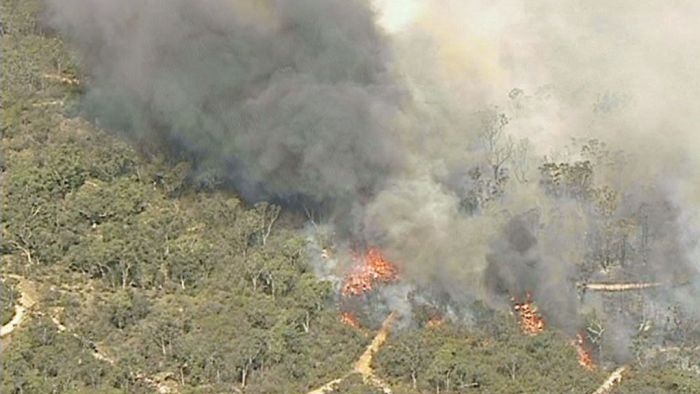 Windsor Downs Nature Reserve ablaze Windsor Downs Nature Reserve ablaze
Mis-identified by media as the ‘Marsden Park Fire’ ..”which started burning in a tip..”
[Source: Two Homes under threat in Sydney grass fire‘, 20130910, Australian Broadcasting Corporation,
^http://www.abc.net.au/news/2013-09-10/two-homes-under-threat-in-sydney-grass-fire/4948314]
.
Why did three wildfires start today in north western Sydney in protected reserves of Sydney’s remnant Cumberland Plains Woodland?
The fires all started around midday during high gusty wind conditions and unseasonally high temperatures. There was no lightning to speak of, so all three fires must have been caused by people.
Reckless burnoffs? Deliberately lit? By the same people? By developers wanting to undermine the Cumberland Plain Woodland and so extend their sprawl?
Whether it was bush arson or recklessness will be a matter for bushfire investigations which need to be mandatory for each and every wildfire. A forth wildfire at Winmalee in the nearby Blue Mountains (the ‘Hawkesbury Road Winmalee Fire‘) was purportedly a neglected hazard reduction burn – the Rural Fire Starters fuelling more work for themselves.
What did each wildfire cost – economic loss, infrastructure loss, productivity loss, direct firefighting costs, indirect costs, social costs? These are never measured or reported. The ecological costs are always ignored because ecology is not deemed to be valuable in our current society. How much death and harm has been infliced upon Windsor Downs Nature Reserve? Such value questions are beyond the thinking of our current society.
The RFS only prioritises saving human life and property. It thus has no different role than the NSW Fire Brigade. So the RFS should not exist. It only exists because the New South Wales government does not want to properly pay for firefighting. The RFS exists as unpaid volunteers so that the NSW government can divert hundreds of millions in taxes to other priorities it somehow considers to be more important.
Then the NSW government appeals for more volunteers to do its dirty work for free.
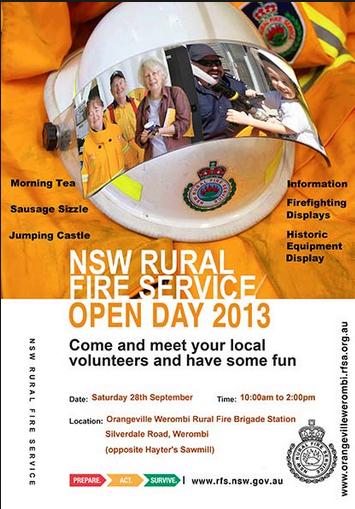  . .
Whereas in New South Wales, a NSW Fire Brigage professional firefighter gets paid $29 an hour minimum. There will be many families that would dearly desire to receive that for their unpaid volunteering efforts.
.
“At Richmond Road and Bennett Road at Windsor, the RFS (New South Wales Rural Fire Service) says a grassfire could impact properties around George Street and the area of Bligh Park. The fire has crossed Garfield Road and is burning in the Windsor Downs Nature Reserve.”
[Sources: ‘Home lost as grass fires rage in Marsden Park and Windsor‘, 20130910, Daily Telegraph newspaper, Sydney, ^http://www.dailytelegraph.com.au/newslocal/the-hills/home-lost-as-grass-fires-rage-in-marsden-park-and-windsor/story-fngr8i1f-1226716140957; ‘Two Homes under threat in Sydney grass fire‘, 20130910, Australian Broadcasting Corporation, ^http://www.abc.net.au/news/2013-09-10/two-homes-under-threat-in-sydney-grass-fire/4948314]
.
The fire authorities have labelled this current fire the ‘Richmond Road Grass Fire‘, so will the records of the fire will be just scattered or erased? Today’s initial account of the fire on the official Rural Fire Service website reads thus :
“..A grass fire burning in the area of Richmond Road and Bennett Road at Windsor”. The fire is burning on both sides of George Street, South Windsor and both sides of Richmond Road. The fire is burning under strong northerly winds. An Emergency Alert telephone message has been sent to residents in these areas.
There is the potential for the fire to impact on properties around George Street and the area of Bligh Park. The fire has crossed Richmond Road and is now burning in the Windsor Downs Nature Reserve.”
.
To put this into geographic perspective, this is a presumed map of the affected area, in absence of RFS public transparency:
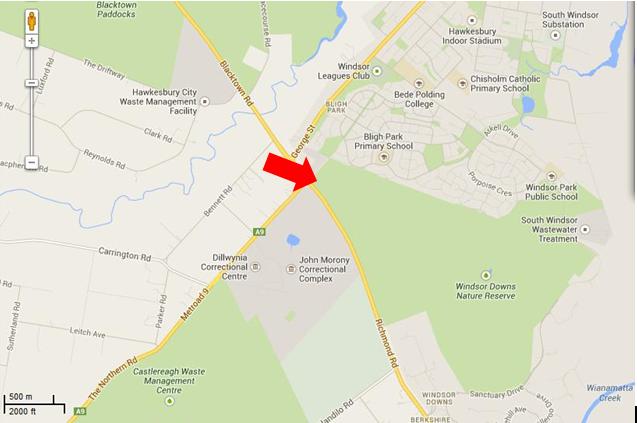
The presumed ignition of the Richmond Road Grass Fire
from Bennett Road, Windsor Downs
(outer north-western Sydney Metropolis)
[Source: Google Maps 2013]
.
<<Emergency warnings have now been issued for four bushfires in Sydney’s far north west, as temperatures in the city exceed 30 degrees with strong northerly winds.
The RFS says five firefighters have sustained smoke inhalation and two have received minor burns.
The fires are at Castlereagh, Richmond, Marsden Park, and Winmalee where one property is alight. At Richmond Road and Bennett Road at Windsor, RFS says a grassfire could impact properties around George Street and the area of Bligh Park. The fire has crossed Garfield Road and is burning in the Windsor Downs Nature Reserve. >>
.
[Ed: Garfield Road is in Riverstone, not Richmond, and is also quite distinct from the separate fire at Windsor Downs. Media reporting has been misleadingly false, overlapping and confused and likely due to naive junior desktop journalism. Worse is that the RFS report is equally confused. Fortunately no person died relying upon officialdom, but the wildlife count is never published].
.
.
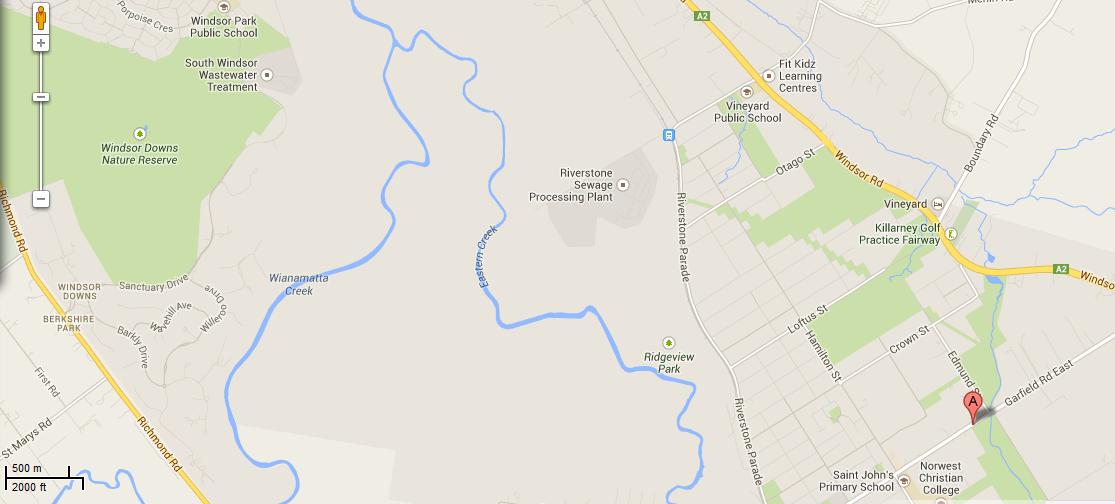 Map showing the juxtaposition of the Windsor Downs Nature Reserve over 3 km north west from Garfield Road in Riverstone.
Journalists have a lot to answer for when it comes to fact checking during emergencies.
[Source: Google Maps 2013, click image to enlarge]
Map showing the juxtaposition of the Windsor Downs Nature Reserve over 3 km north west from Garfield Road in Riverstone.
Journalists have a lot to answer for when it comes to fact checking during emergencies.
[Source: Google Maps 2013, click image to enlarge]
.
<< About 3,200 homes in the Richmond area have lost power and Endeavour Energy says it is working to get the supply back. The RFS says the fire is burning intensely under strong winds.
In Marsden Park, a grass fire is burning out of control and has crossed Garfield Road. While at Castlereagh, near Penrith, an emergency warning was issued around noon (AEST) for a fire which has destroyed a shed and burned 60 hectares. About 50 homes are thought to be under threat. The fire is burning around properties on Devlin Road and is moving towards homes on Nutt Road.
RFS Inspector Ben Shepherd says the conditions are difficult for firefighters.
RFS Inspector Ben Shepherd:
“I’m currently sitting on Nutt Road and the fire is moving quickly towards some homes in that area. The actual fire itself is putting up a huge column of smoke… and the wind continues to be quite strong. Because of that, that’s starting to send a couple of spot fires ahead of the main fire front itself.”
.
Local resident Kelly Elson has been evacuated from her home near the fire front. She says she first noticed the fire at about 10:30 this morning.
Windsor resident Troy Evans says that fire started in grass near his house on Bennett Road.
Windsor resident Troy Evans:
“So I went and told the firies ‘you better get a couple of trucks round here real quick’ which they did, luckily. They got the place under control then the wind turned and it’s just roared up through next door, jumped the road, it’s gone through the church, it’s over in the bus bay, it’s meant to have taken a couple of houses out in Bligh Park. Now it’s on it’s way into the jail, it’s just crazy.”
.
A very high fire danger alert has been issued for the Illawarra, Sydney, the Central Ranges, the Hunter, the north west and the north coast. More than 40 uncontained bushfires are currently burning across New South Wales.
Mr (RFS Commissioner Shane) Fitzsimmons says it is hot, dry and windy in most of the state today, with seven districts in very high fire danger. He says he is worried about the unseasonally warm start to spring on the back of a dry winter.
The RFS is urging property owners in semi-rural and rural areas to think about the conditions before they burn off land.”
.
[Ed: Fitzsimmons, why blame the weather and not the landholder who is accused of causing the ignition?]
.
[Source: ‘Homes under threat from bushfires at Castlereagh and Windsor in Sydney’s far north west’, 20130910, Australian Broadcasting Corporation, ^http://www.abc.net.au/news/2013-09-10/two-homes-under-threat-in-sydney-grass-fire/4948314]
.
[Ed: So the RFS is urging property owners in semi-rural and rural areas to think about the conditions before they burn off land.
Is this head office code for the known landholder who caused the fire and the RFS being too public servant skin timid to lay charges? So why is the landholder in Bennett Road not under arrest for suspected arson?]
.
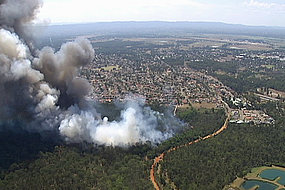
The fire inside the Windsor Downs Nature Reserve today
.
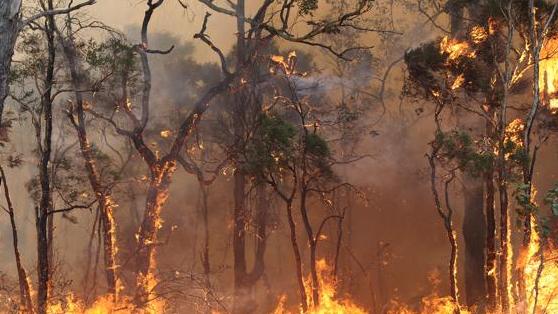 Windsor Downs native woodland habitat being burned alive
[Source: ‘Bushfires threaten Sydney’s western suburbs – NSW Rural Fire Service issues emergency warnings’, 20130910, Sydney Morning Herald newspaper (Sydney), ^http://www.smh.com.au/environment/bushfires-threaten-sydneys-western-suburbs-nsw-rural-fire-service-issues-emergency-warnings-20130910-2thnl.html] Windsor Downs native woodland habitat being burned alive
[Source: ‘Bushfires threaten Sydney’s western suburbs – NSW Rural Fire Service issues emergency warnings’, 20130910, Sydney Morning Herald newspaper (Sydney), ^http://www.smh.com.au/environment/bushfires-threaten-sydneys-western-suburbs-nsw-rural-fire-service-issues-emergency-warnings-20130910-2thnl.html]
.
.
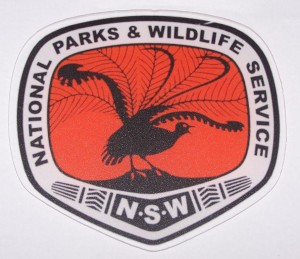 A liar bird of disinterested political masters A liar bird of disinterested political masters
.
http://www.youtube.com/watch?v=VktLOr4M46U
.
Cumberland Plain Woodland
.
Cumberland Plain Woodland including the Windsor Downs Nature Reserve, the nearby Castlereagh Nature Reserve and Agnes Banks Nature Reserve, all fall under the custodial management responsibility of the National Parks and Wildlife Service New South Wales – a state body.
Windsor Downs Nature Reserve features.. << an historic windmill and water tank protects a number of endangered plant communities and includes species such as the broad-leafed ironbark, grey box, scribbly gum, narrow-leafed angophora, pea flowers and a species of geebung.
Several bird species have been recorded – the red-capped and hooded robins, white-winged choughs, buff-rumped and yellow-tailed thornbills and the endangered regent honeyeater – which are usually found in the drier habitats of the central west slopes. >>
[Source: NSW Government, ^ http://www.environment.nsw.gov.au/NationalParks/parkHome.aspx?id=N0598]
.
Windsor Downs Nature Reserve is not just set aside for picnics. It is a remant ecological community with the fast disappearing Cumberland Plain Woodland. It is supposed to be protected.
.
<< The Cumberland Plain Woodland is the name for the distinct groupings of plants that occur on the clay soils derived from shale on the undulating Cumberland Plain in central New South Wales. The most commonly found trees in the woodland are Grey Box Eucalypts Eucalyptus moluccana, Forest Red Gums Eucalyptus tereticornis, Narrow-Leaved Ironbarks Eucalyptus crebra and Spotted Gum Eucalyptus maculata. A variety of other lesser-known eucalypts as well as shrubs, grasses and herbs are also found. It is the dominance of Grey Box and Forest Red Gum that makes the community distinctive.
In 1877 Cumberland Plain Woodland covered 107,000 hectares occupying approximately 30 per cent of the Sydney Basin. This community type was once widespread in the Plains but has been reduced to a few fragmented stands by human use for farming, industry and housing. Today less than six per cent remains in small fragments scattered across the western suburbs of Sydney, totalling only 6400 hectares. The remaining fragments occur in areas subject to intense pressure from urban development.
Although some areas occur within conservation reserves, this is in itself not sufficient to ensure the long-term survival of the community unless the factors threatening the integrity and survival of the community are eliminated.
The remaining stands of this ecological community are threatened by the spread of the Sydney suburban areas. Threats include clearance for agriculture, grazing, hobby and poultry farming, housing and other developments, invasion by exotic plants and increased nutrient loads due to fertiliser run-off from gardens and farmland, dumped refuse or sewer discharge.>>
[Ed: and of course ‘bushfire’, which the government does not like to include out of embarassment of neglect, yet which is causes the most devastating impact].
.
[Source: ‘Woodlands vanishing from Sydney’s outskirts’, by Environment Australia, Australian Government, ^http://www.environment.gov.au/biodiversity/threatened/publications/cumberland.html]
.
Cumberland Plain Woodland in the Sydney Basin Bioregion – proposed critically endangered ecological community listing
.
<< The NSW Scientific Committee, established by the Threatened Species Conservation Act, has made a Preliminary Determination to support a proposal to list the Cumberland Plain Woodland in the Sydney Basin Bioregion as a CRITICALLY ENDANGERED ECOLOGICAL COMMUNITY on Part 2 of Schedule 1A of the Act and as a consequence, to omit reference to Cumberland Plain Woodland from Part 3 of Schedule 1 (Endangered Ecological Communities) of the Act. The listing of Critically Endangered Ecological Communities is provided for by Part 2 of the Act.
The Scientific Committee has found that:
1. Cumberland Plain Woodland was listed as an Endangered Ecological Community under the Threatened Species Conservation Act 1995 in June 1997 (NSW Scientific Committee 1997). Since this listing, a large volume of new data and analyses have become available. In addition, a nomination to change the status of Cumberland Woodland to Critically Endangered status has been received. This Determination addresses additional information now available in accordance with current listing criteria under the Threatened Species Conservation Regulation 2002.
2. Cumberland Plain Woodland is the name given to the ecological community in the Sydney Basin bioregion associated with clay soils derived from Wianamatta Group geology, or more rarely alluvial substrates, on the Cumberland Plain, a rainshadow area to the west of Sydney’s Central Business District. >>
<<..high frequencies of fires may result where fragmentation increases the interface between urban areas and bushland, as this results in increased arson, car dumping, planned fuel-reduction fires and accidental ignitions.
High fire frequencies are associated with reduced diversity of native plant species in Cumberland Plain Woodland (Watson 2005). ‘High frequency fire resulting in disruption of life cycle processes in plants and animals and loss of vegetation structure and composition’ is listed as a Key Threatening Process under the Threatened Species Conservation Act 1995.
The season of fire, which may be altered as a consequence of hazard reduction fires, may also influence the species composition of the grassy woodland understorey (Knox & Clarke 2006; Benson & von Richter 2008).
Disruption of ecological processes associated with alteration of fire regimes contributes to a very large reduction in ecological function of the community. >>
.
[Source: ‘NSW Scientific Committee – preliminary determination’, Australian Government, ^http://www.environment.nsw.gov.au/determinations/cumberlandplainpd.htm]
.
But wait, there is a:
which reads…

.
The official Fire Management Strategy has been conveniently removed from public access on the National Parks and Wildlife Service (NPWS) website.
However, the following extracts from the similar and nearby Agnes Banks Nature Reserve are instructive as to the approach taken by NPWS management on all nature reserves across the Sydney Basin that comprise remnant ecology of the Cumberland Plain Woodland.
.
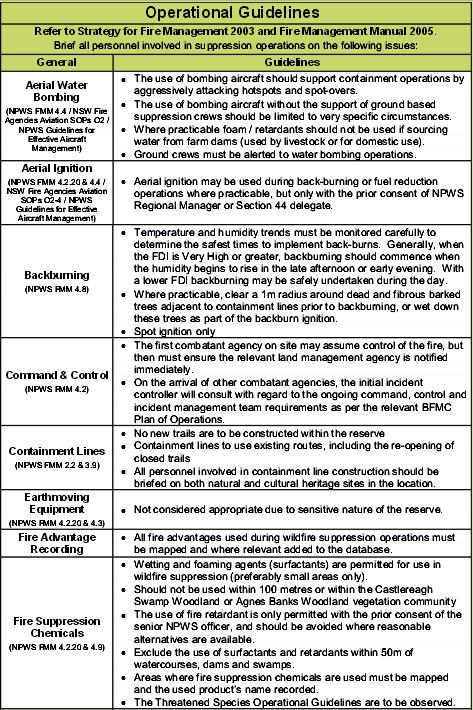
.
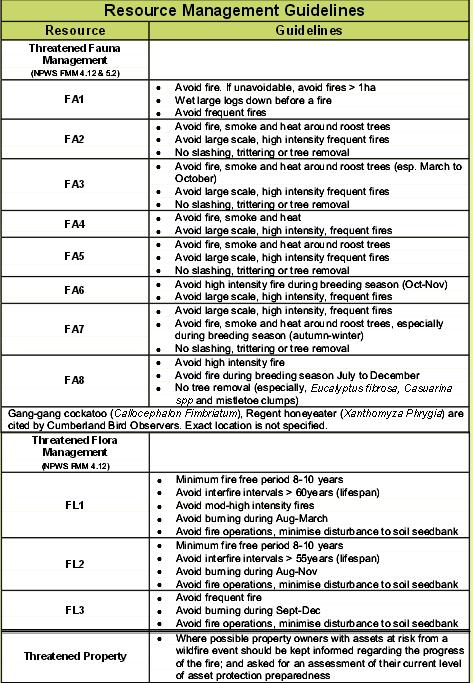
Source: ‘Agnes Banks Nature Reserve Fire Management Strategy, 2006, (last modified 20070323), NPWS (NSW), NSW Government, ^http://www.environment.nsw.gov.au/resources/parks/06354AgnesBanksFMS.pdf]
.
[Ed: Disturbingly noted is that the NPWS ‘ecological’ policy is that it ok to burn these woodland reserves every 8 years. So government care factor about bushfire impact?]
.
<<..little research has been undertaken into fire management prescriptions for Cumberland Plain woodland and forest associations when compared to the nearby Hawkesbury sandstone communities.>>
~ Windsor Downs Nature Reserve et al. Plan of Management (NPWS 1999,p.18)
.
The official Bureau of Meteorology had in the days prior, forecast strong gusty north westerly winds for the western Sydney region for both yesterday and today, following a few days of calm winds. The Rural Fire Service would have been well aware of this forecast, the extreme bushfire conditions that this posed and the considerable escalated risk of damaging wildlfires.
The subsequent actual weather observations for Richmond are telling. Look at the 10th. The arsonists know what they are doing.
.
 [Source: Australian Bureau of Meteorology,
^http://www.bom.gov.au/climate/dwo/201309/html/IDCJDW2119.201309.shtml] [Source: Australian Bureau of Meteorology,
^http://www.bom.gov.au/climate/dwo/201309/html/IDCJDW2119.201309.shtml]
.
Reliant mainly on public calls to ‘000’, fire trucks and road-routed volunteers, the RFS continues to be grossly under-equipped to handle wildlfires in a timely and effective manner, which increasingly to many is unacceptable to bushfire prone communities in this now 21st Century.
.
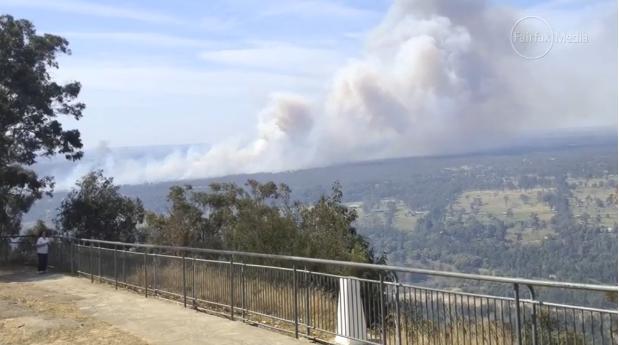 Windsor Downs Nature Reserve ablaze (from Hawkesbury Lookout) Windsor Downs Nature Reserve ablaze (from Hawkesbury Lookout)
[Source: ‘Hazard reduction burn started major Sydney bushfire’, by Megan Levy, Sydney Morning Herald, 20130913,
^http://www.smh.com.au/nsw/hazard-reduction-burn-started-major-sydney-bushfire-20130913-2tois.html]
.
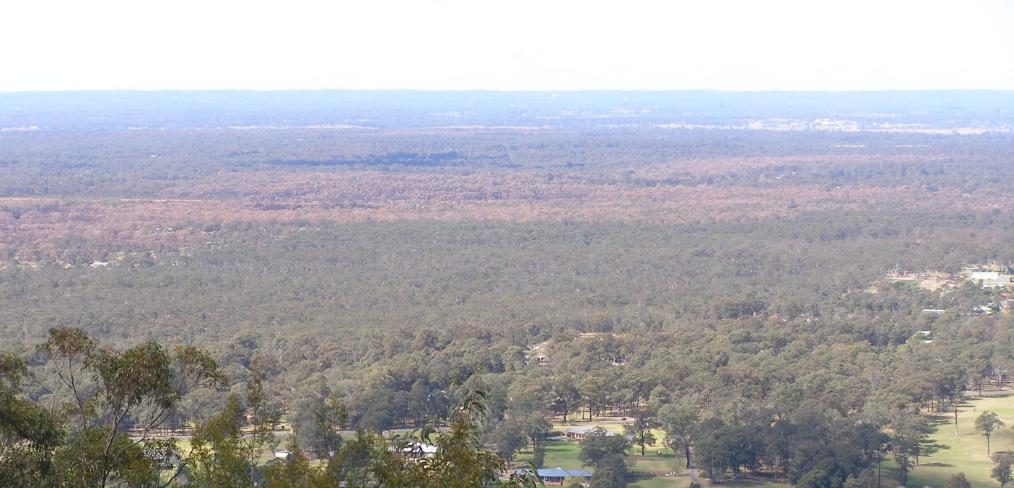 Windsor Downs Nature Reserve incinerated (see browned woodland canopy in centre of photograph)
[Photo taken by Editor from Hawkesbury Lookout looking north east on 20130921, photo © under ^Creative Commons]
Click image to enlarge Windsor Downs Nature Reserve incinerated (see browned woodland canopy in centre of photograph)
[Photo taken by Editor from Hawkesbury Lookout looking north east on 20130921, photo © under ^Creative Commons]
Click image to enlarge
.
Steadily year on year, the last bushland reserves that provide critical remnant habitat around Sydney are being destroyed. Before long the only bushland will be that in suburban gardens, and the wildlife will be finally made regionally extinct.
.
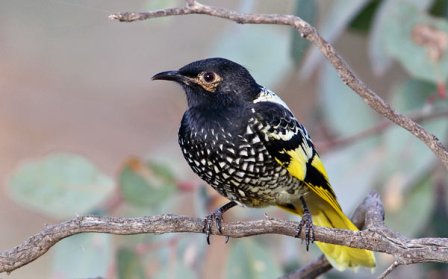 Critically Endangered Regent Honeyeater
(Anthochaera phrygia)
A native bird species dependant upon a disappearing habitat
Humans obliterated its habitat for logging, farming and housing
Then we constrained it to a few nature reserves like Windsor Downs,
Then we burnt the reserve. Critically Endangered Regent Honeyeater
(Anthochaera phrygia)
A native bird species dependant upon a disappearing habitat
Humans obliterated its habitat for logging, farming and housing
Then we constrained it to a few nature reserves like Windsor Downs,
Then we burnt the reserve.
.
.
.
Further Reading:
.
[1] ‘NSW Scientific Committee – preliminary determination‘, Australian Government, ^http://www.environment.nsw.gov.au/determinations/cumberlandplainpd.htm
.
[2] ‘Castlereagh, Agnes Banks and Windsor Downs Nature Reserves – Plan of Management‘, NSW Government, ^http://www.environment.nsw.gov.au/resources/parks/pomfinalagnescastlereagh.pdf
.
Footnote
.
‘Hunt for arsonist over western Sydney bushfire’
[Source: ‘Hunt for arsonist over western Sydney bushfire’, Friday 20130913, ABC, ^http://www.abc.net.au/news/2013-09-13/hunt-for-arsonist-over-western-sydney-bushfire/4956022]
.
<<Authorities say they believe a fire that destroyed a home at Marsden Park in Sydney’s west on Tuesday was deliberately lit. Investigators have also not ruled out that an arsonist may have caused a blaze at nearby Londonderry. Police are now calling for witnesses to help identify the person responsible for sparking the Marsden Park fire.
Assistant Commissioner Alan Clarke says it is believed the fire began on Grange Avenue just after midday on Tuesday.
.
Alan Clarke:
.
“There are crime scene indicators at the source of that fire that would lead us to suspect arson activity. I really can’t tell you more than that at the moment. It’s mainly our crime scene indicators and forensic evidence that would have us raise that suspicion. If anyone has information, if anyone saw any suspicious activity in or around that fire location, any part of it… please pass that information on for the benefit of police.”
.
Rural Fire Service Deputy Commissioner Rob Rogers has confirmed another serious fire at Winmalee, in the lower Blue Mountains, was caused by a hazard reduction burn conducted by the NSW National Parks and Wildlife Service.
.
Rob Rogers:
“That fire was burn on the weekend, it was patrolled on Monday, there was smouldering activity. That fire then jumped containment lines on the Tuesday and became an active fire. The winds on that day did exceed forecast and they were around 90 kilometres an hour, and obviously that tested the control lines on that hazard reduction and it did escape. In these strong winds branches came off trees, hit the powerlines, the powerlines were brought down, they ignited grass in that area and that was the cause of that fire. You would have to obviously be suspicious that it did come from the hazard reduction, given that it was in a very close proximity to it.”
.
Investigators have found a fourth fire that began on Richmond Road at Windsor Downs was sparked by downed power lines. The investigation into a fire that closed the M1 motorway, formerly known as the F3, north of Sydney yesterday is continuing, with another hazard reduction burn the suspected cause. Assistant Commissioner Alan Clarke has warned those that deliberately light fires or cause them through negligence will be caught.
.
Alan Clarke:
“Last year we arrested 87 individuals and they faced charges in respect of bushfire and fire related activity for 117 charges. We know this year again we will be putting offenders before the court. It’s sad but it’s true.”
.
Tags: A liar bird of disinterested political masters, Agnes Banks Nature Reserve, Castlereagh Nature Reserve, Cumberland Plain Woodland, Hawkesbury Road Winmalee Fire, Marsden Park Fire, NPWS, NSW Fire Brigade, NSW National Parks and Wildlife Service, Retained Firefighter, Richmond Road Grass Fire, Rural Fire Starters, Windsor Downs Nature Reserve
Posted in Birds (Australian), Critically Endangered Wildlife (CR), Threats from Bushfire | No Comments »
Add this post to Del.icio.us - Digg
Tuesday, September 3rd, 2013
 Offering to their Fire God Supreme Offering to their Fire God Supreme
.
When the wind is calm, a special cult emerges that yearns the desire for fire, the Rural Fire Starters (RFS).
Playing with fire in rural Australia is like messing with the Devil. The consequence can be catastrophic – death, maiming, economic loss. Each quite evil.
Arson is criminal. Arson is not just lighting fires to buildings. It is lighting fires that causes destruction. Arson attracts either a $14,000 fine or a long jail term.
Calm wind triggers a hazard reduction burn offering to their Fire God Supreme.
.
 RFS/NPWS: “Burning doesn’t hurt. Burning is good for ecology.”
“Set fire to others as you would never under Hades have them do unto you.” RFS/NPWS: “Burning doesn’t hurt. Burning is good for ecology.”
“Set fire to others as you would never under Hades have them do unto you.”
.
The ritual prescribes setting fire to bushland and wildlife habitat, where the flames reach the same height as a wildfire. Thousands of hectares are burnt every year as demanded by the cult’s ritual.

.
To outsiders, the justification for the HR ritual bush arson is to prevent wildfires.
 Any growth after a firestorm means regeneration, extrapolated to ‘killing is OK ‘.
[Source: ‘New life for the state’s north-east after a trial by fire’, 20030405,
Photo at Victoria’s Mount Beauty by Jason South,
^http://www.theage.com.au/articles/2003/04/04/1048962933714.html] Any growth after a firestorm means regeneration, extrapolated to ‘killing is OK ‘.
[Source: ‘New life for the state’s north-east after a trial by fire’, 20030405,
Photo at Victoria’s Mount Beauty by Jason South,
^http://www.theage.com.au/articles/2003/04/04/1048962933714.html]
.
RFS reality is that when wildfires do occur, often started by people or else ignitions in bushland left to burn and spread for hours and days, they become wildfires, so same outcome regardless: Death to the last of Ecology.
RFS reality perpetuates the colonial destruction mindset of the fragmented vital ecology that remain in New South Wales and Australia.
On the radio today, the RFS media spokesperson declared that the hazard reduction focus was on a wild area that hadn’ been burnt for some time. This implied that the RFS mindset about wildlife habitat is that it is only singularly a threat. If bushland and forest has not been burnt for some time then according to the bushphobic cult, it must be burnt. Dense undergrowth in the eyes of the RFS is evil. May it dare exist anywhere in New South Wales, burn it save it catch fire.
.
RFS firefighter convicted of arson
.
 RFS Firefighter, Joshua Staples
Finally jailed this week for lighting blazes in western Sydney
RFS arsonists look like anyone in the street
Photo by John Grainger, Daily Telegraph (Sydney newspaper) RFS Firefighter, Joshua Staples
Finally jailed this week for lighting blazes in western Sydney
RFS arsonists look like anyone in the street
Photo by John Grainger, Daily Telegraph (Sydney newspaper)
.
<< A Rural Fire Service volunteer who lit a string of fires before helping to put them out will spend at least a year behind bars. (Ed: not enough)
Magistrate Michelle Goodwin today sentenced 20-year-old Joshua Staples to 18 months’ jail with a non-parole period of one year.
His mother, Jennifer Carter, grinned and called out “You right mate?” as her son was handcuffed and led from Sydney’s Downing Centre Local Court.
The evidence by Staples’ mother was rejected as a lie, who had told the court any number of family or friends could have been driving the cars spotted at the scenes of the fires.
Staples, from Badgerys Creek, was convicted of deliberately starting multiple grass and bin fires at Bringelly, Badgerys Creek and Greendale in January 2011.
In several instances, Staples then joined his RFS colleagues and helped extinguish the blazes, the court heard.
His lawyer had pushed for a part-time or non-custodial sentence.
“The offences are out of character for him, he’s unlikely to reoffend, and has positive prospects for rehabilitation,” Michael Coroneous told the court. Mr Coroneous said his client had only recently turned 18 when he lit the fires, and his immaturity should be considered. “He was one month and 21 days over the cut-off mark,” he said.
.
(Ed: Arsonist Lawyers will say anything for their clients)
.
Magistrate Goodwin said a psychiatrist’s report showed there were “no psychiatric issues apparent” but “the offender still maintains his innocence. It is therefore difficult to assess any prospects for rehabilitation,” she said before handing down her sentence. I am firmly of the view that the only appropriate sentence … will be a sentence of full-time custody.”
Staples will serve nine terms of 18 months concurrently.
His grandmother Veletta Heron, who crucially told Staples’ trial that her grandson had broken down at her kitchen table and confessed to lighting the fires, was not in court to see him sentenced. In the hearing in January, Ms Heron gad said that she was trying to help her grandson with legal paperwork after he was charged, and asked him to explain police surveillance photos that showed his car near the site of a blaze.
“He was very quiet and I looked up and he was crying,” Mrs Heron said at the hearing. “I don’t think I’ve ever seen Josh cry as much. He was red and had tears running down his face. “I said ‘what’s the matter?’ and he said ‘I did them’. “I stopped for a moment and I tried to think what to say and I said ‘what did you do, Josh?’ and he said ‘the fires’.”
Staples broke down during his evidence and told the court his grandmother was lying. >>
.
[Sources: ‘Jail for firefighter turned arsonist‘, 20130902, by AAP, ^http://www.theaustralian.com.au/news/nation/jail-for-firefighter-turned-arsonist/story-e6frg6nf-1226708936041; ‘RFS volunteer found guilty of lighting fires‘, 20130516, by Stephanie Gardiner, Goulburn Post, ^http://www.goulburnpost.com.au/story/1505961/rfs-volunteer-found-guilty-of-lighting-fires/http://www.goulburnpost.com.au/story/1505961/rfs-volunteer-found-guilty-of-lighting-fires/]
.
 Everyone for themselves Everyone for themselves
.
“During the past 10,000 years, during the Holocene, Australia’s (tectonic) global position has changed very little, but there have been enormous changes in its flora and fauna. These changes have occurred since the first people arrived in Australia, but most dramatics have happened during the last 200 years, since the European settlement (invasion) of Australia.
During this very short period of Australia’s history, an estimated 20 billion trees have been removed (decimated) from 70% of the continent for agriculture, and dozens of plants and animals have been introduced and become wild. Whole ecosystems have been affected and many native plants and animals have become extinct.”
“..During the last 200 years land has been overstocked and overcropped, damaging fragile soils, increasing erosion and causing choking dust storms. Limted water resourses have been mismanaged, leading to a rising tide of underground salt and silting of waterways. Fertilisers, pesticides, herbicides and other chemicals have poisoned soils and waterways.
Traditional European farming practices were not sustainable in the new homeland and native wildlife and habitats suffered badly.
At least 40 Australian frogs, 120 reptiles, 200 birds and mammals, 35 species of freshwater fish and more than 3000 plants species have become extinct – the worst record for sany continent.”
[Source: ‘The Evolution of Australia: 110 million years of change’, 2002, Australian Museum Trust, (printed book), pp.59, 61]
.
 Native Brushtailed Possum badly burnt (paws included) in bushfire because it had nowhere to go up its Eucalypt
“DEC officers have since reported that most of the animals they have come across are dead.”
[Source: Furries badly burnt in Lake Clifton blaze’, 20110112,
^http://www.watoday.com.au/wa-news/furries-badly-burnt-in-lake-clifton-blaze-20110112-19nge.html] Native Brushtailed Possum badly burnt (paws included) in bushfire because it had nowhere to go up its Eucalypt
“DEC officers have since reported that most of the animals they have come across are dead.”
[Source: Furries badly burnt in Lake Clifton blaze’, 20110112,
^http://www.watoday.com.au/wa-news/furries-badly-burnt-in-lake-clifton-blaze-20110112-19nge.html]
.
Ed: Want a definition of evil?
Watch wildlife burn to death in a bushfire,
sickly “controlled” or “prescribed” or otherwise.
.
Fire is a key threatening process that locally and regionally causes fauna extinctions, especially to territorial mammals that cannot relocate. But the RFS does not employ zoologists or ecologists on the side of fauna. They would only question the cult’s bizarre premise – ‘fire is good for wildlife’.
To unto others?
 So volunteers do as they are told by the RFS and NPWS command
to go set fire to the bush, but they know not what they do.
Wildlife burn just like humans. Slow moving Echidna’s, Wombats, what of them?
So volunteers do as they are told by the RFS and NPWS command
to go set fire to the bush, but they know not what they do.
Wildlife burn just like humans. Slow moving Echidna’s, Wombats, what of them?
.
The RFS bushphobic cult has usurped all logical decision making, and all independent thought. The cult prescribes that if native habitat has not been burnt for years, it must be deemed a threat and so must be burnt, and so coloured red on the To Burn map. Such is the unquestioned extent of cult mindset that it harks to the ancient and backward ‘Trial by Ordeal’ of drowning witches. If the accused drowned she was innocent, but if she didn’t drown then she must be a witch and so punished by being burnt to death.
.
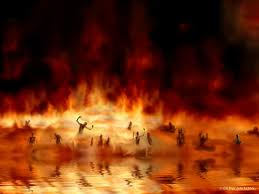 “And if anyone’s name was not found written in the book of life,
he was thrown into the lake of fire.”
~ The Bible, Revelation 20:15 “And if anyone’s name was not found written in the book of life,
he was thrown into the lake of fire.”
~ The Bible, Revelation 20:15
.
The weak underbelly of the cult is that in the event of a real wildfire, Rural Fire Starters are as wholly incompetent and ill equipped as a Dad’s Army.
Rural Fire Starters are:
- Incompetent and ill equipped to detect ignitions in a timely manner
- Incompetent and ill equipped to immediately respond to ignitions in a timely manner
- Incompetent and ill equipped to suppress ignitions from becoming wildfires
.
 “Who are you then?”
“I am part of that power which eternally wills evil and eternally works good.”
~ Johann Wolfgang von Goethe.
“Who are you then?”
“I am part of that power which eternally wills evil and eternally works good.”
~ Johann Wolfgang von Goethe.
.
Like the exclusive brethren, the absolutism of the Rural Fire Starting cult prevails. Involvement is entirely religious and wholly submissive to government cost saving policy.
Here, we supply the uniforms and equipment so that you may go forth and do RFS dirty work…
.
 Anyone can set fire to Nature
New members welcome
Our indoctrination demands complete media silence, no pay, no questioning.
Anyone can set fire to Nature
New members welcome
Our indoctrination demands complete media silence, no pay, no questioning.
.
.
 “The thief comes only to steal and kill and destroy.
I came that they may have life and have it abundantly.”
~ The Bible, John 10:10
“The thief comes only to steal and kill and destroy.
I came that they may have life and have it abundantly.”
~ The Bible, John 10:10
.
Tuesday, July 2nd, 2013
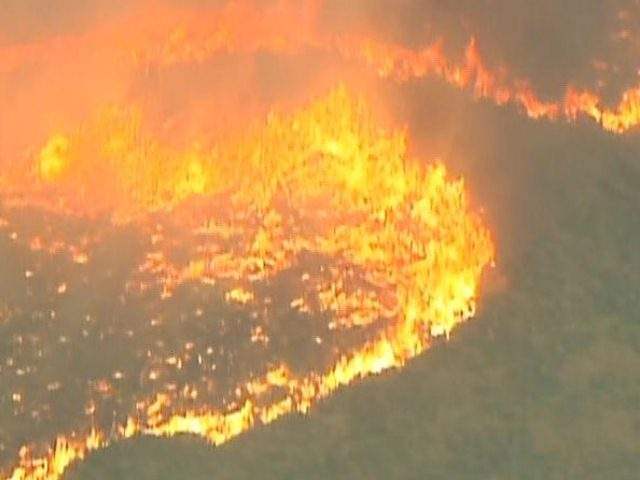 America tragically loses 19 elite firefighters in an Arizona Wildfire
[Source: ‘Arizona firefighter deaths’, 20130702, by Holly Yan, Eliott C. McLaughlin and Jason Hanna, CNN, ^http://edition.cnn.com/2013/07/01/us/arizona-firefighter-deaths/index.html] America tragically loses 19 elite firefighters in an Arizona Wildfire
[Source: ‘Arizona firefighter deaths’, 20130702, by Holly Yan, Eliott C. McLaughlin and Jason Hanna, CNN, ^http://edition.cnn.com/2013/07/01/us/arizona-firefighter-deaths/index.html]
.
An American elite squad of wildfire firefighters perished last Sunday 28th June 2013 while actively setting up containment barriers in front of an out-of-control wildfire front.
The 19 firefighters who tragically perrished in the blaze were members of the Prescott Fire Department’s Granite Mountain Hotshots. The fire concerned was termed the Yarnell Hill Wildfire, about 80 km northwest of the city of Phoenix, Arizona.
Prescott Fire Chief Dan Fraijo, who sent the unit at the request of regional authorities, said he was told that one of the firefighters had radioed they were about to deploy their fire shelters, a sort of aluminum blanket that protects against the flames and heat — and a measure of last resort.
.
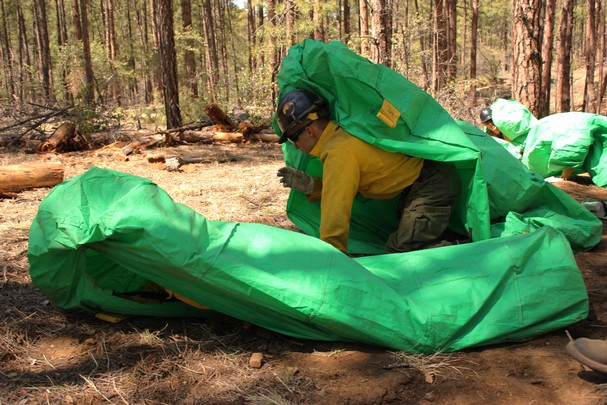 Flawed Survival Strategy demands questions/ Class Action
Flawed Survival Strategy demands questions/ Class Action
.
.
Yarnell Hill Wildfire
.
Day 1
.
The wildland fire is believed started by lighting at around 5:30 pm on Sunday 28th June 28, 2013 near the township of Yarnell (pop. 700) Arizona.
Medium winds at the time (up to 35 kph) whipped up the flames and pushed the fire out of control into a wildlife front through a tinder dry forest vegetation long subjected to an extended drought. By day’s end the wildfire has spread to over 2,000 acres (810 hectares).
A highest qualified, Type 1 elite squad of 19 wildfire firefighters (members of the Prescott Fire Department’s Granite Mountain Hotshots) were sent in ahead of the fire front to set up containment barriers to prevent the fire impacting the downwind township of Yardell. They were all overrun by the fire and perished. In the late afternoon, a Type 2 Incident Management Team (IMT) was in charge of the fire. A Type 2 fire-fighting team is a State-certified but has less training, staffing and experience than Type 1 IMTs, and is typically used on smaller scale national or state incidents.
Firefighting resources included 16 tank engines, eight water tenders, two crash/rescue vehicles, two structure protection vehicles, one bulldozer, one hotshot crew (that perished), seven type 2 handcrews and a camp crew.
On order were an additional four Type 2 crews, four Type 1 hotshot crews, one Very Large Airtanker (VLAT) and an air attack unit.
The nearby Arizona State Route 89 was shut down shortly after the fire started and the total evacuation of Yarnell and partial evacuation of Peeples Valley was ordered as well. Some 600 people were put under mandatory evacuation orders. An evacuation shelter was set up at Yavapai College in Prescott, with members of the Red Cross providing cots and blankets for overnight stays. Meals and medical assistance were also provided to residents.
A second evacuation shelter was set up at Wickenburg High School in nearby Wickenburg because the closure of State Route 89 made it impossible for some people to reach the first shelter. The two shelters are serving individuals, families and small animals; large animals were sheltered at the Hidden Springs Ranch in Peeples Valley.
.
Day 2
.
The Clay Templin’s Southwest Area Type 1 Incident Management Team assumed management of the fire. About 200 more firefighters arrived to the scorching mountains, doubling the number of firefighters battling the blaze.
By day end, half of Yarnell, about 200 to 250 homes, had been destroyed and the fire had grown to over 8,300 acres (3,360 ha).
.
Day 3
.
By the morning of July 2 the fire had grown another 798 acres to a total of 9,172 acres, as mapped by an infrared aircraft flight. The fire was still at zero containment. Resources included five Type 1 (hotshot) crews, seven Type 2 crews, three Type 1 (heavy) helicopters, two Type 2 (medium) helicopters, two Type 3 (light) helicopters, and 36 engines.
The fire was still completely uncontrolled, with more than 400 firefighters on the line.
.
Questions of the U.S. Fire Administration
.
Before the 19 deaths in Arizona, 43 firefighters had been killed so far in 2013, according to the U.S. Fire Administration. A total of 83 firefighters died last year while on duty.
This is unacceptable in 2013 in the wealthiest and most technologically advanced country on the planet.
.
- What is the cost-benefit of putting ANY firefighters (paid or otherwise) in the direct path of a firestorm? Benefit: nil? Cost: the ultimate cost?
- What were the methods of wildfire detection used by the U.S. Fire Administration at this known high risk region under extreme wildlfire weather conditions 24/7?
- Are infrared geostationary satellites in place to immediately detect wildfire ignitions in known high risk regions at known high risk weather conditions 24/7? If not, why not?
- Are wildfire ignitions monitored by satellite immediately communicated to the U.S. Fire Administration and incident crews 24/7? If not, why not?
- What was the elapsed time delay:
- Between estimated actual ignition(s) and detection by the U.S. Fire Administration? Is this time lapse acceptable to communities vulnerable during such extreme risk conditions?
- Between detection by the U.S. Fire Administration and actual onground firefighting response? Is this time lapse acceptable to communities vulnerable during such extreme risk conditions?
- Between detection by the U.S. Fire Administration and airborne water dumping hitting the fire front? Two hours? Five hours?
- Why was not multiple co-ordinated airborne response not immediately deployed within the first critically hour of the ignition to suppresss the fire while it was small and comparatively containable?
- Would such a dedicated co-ordinated military strategy have saved the 19 Granite Mountain Hotshots and the town of Yardell?
- Is the massive cost of military-scale wildlife monitoring and readiness justified to avoid loss of life in future? This is a value decision for vulnerable communuties.
.
 In 1804, one William Clark recorded perhaps the first account of a wildland fire fatality in US history.
“The Prarie was Set on fire (or cought by accident) by a young man of the Mandins, the fire went with such velocity that it burnt to death a man & woman, who Could not get to any place of Safty (sic).”
Two hundred years hence, Americans have wised up some or have they? In 1804, one William Clark recorded perhaps the first account of a wildland fire fatality in US history.
“The Prarie was Set on fire (or cought by accident) by a young man of the Mandins, the fire went with such velocity that it burnt to death a man & woman, who Could not get to any place of Safty (sic).”
Two hundred years hence, Americans have wised up some or have they?
.
Thursday, May 16th, 2013
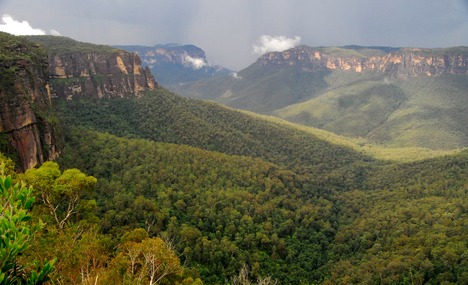 Grose Valley inside the Blue Mountains National Park (World Heritage) Grose Valley inside the Blue Mountains National Park (World Heritage)
before the Parks Service let a fire burn through it out of control
in the Spring of 2006
[Photo by Ian D Smith]
.
20 Sep 2006: (2 months prior) Parks Service maximises hazard reduction burns
.
<<With warmer days just around the corner and continuing dry weather the Blue Mountains Region National Parks and Wildlife Service (Parks Service) is again undertaking rigorous preparation for the coming fire season.
“Every year around this time the Parks Service runs a number of fire preparedness days to ensure staff and fire-fighting equipment are fully prepared for the season ahead”, said Minister for the Environment Mr Bob Debus.
“Fire preparedness days require fire-fighting staff to check their personal protective equipment, inspect fire-fighting pumps and vehicles and ensure that communication equipment and procedures are in place and working before the fire season begins.”
Mr Debus said a number of exercises, including four-wheel drive and tanker driving, first aid scenarios, entrapment and burnovers, were also employed to re-familiarise staff with all apsects of fighting fires.
“Burnovers, where fire-fighters are trapped in a vehicle as fire passes over it, is one of the worst case scenarios a fire fighter can face so pre-season practice is critical to ensure that their response is second nature”, he said.
“Local fire-fighters have also undergone stringent fitness assessments to make sure they are prepared for the physical demands of fire-fighting – like being winched from a helicopter into remote areas with heavy equipment, to work longs hours under very hot and dry conditions wearing considerable layers of protective clothing”, Mr Debus explained.
Mr Debus said that fire preparedness and fitness assessment days worked in conjunction with a number of other initiatives as part of a year-long readiness campaign for the approaching summer.
.
“Over the past 12 months, NPWS officers have conducted more than 150 hazard reduction burns on national park land across NSW. Nineteen hazard reduction burns have been conducted in the Blue Mountains region covered more than 4500 hectares.” said Debus.
.
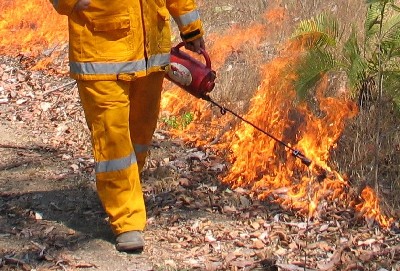 Setting fire to bushland starts bushfires, strangely enough Setting fire to bushland starts bushfires, strangely enough
.
[Ed: These did nothing to prevent the Grose Fires. In fact it was one of the hazard reduction burns deliberately ignited by the Parks Service with the Hartley Vale Rural Fire Service along Hartley Vale Road that escaped over the Darling Causeway that was the main cause of the Grose Fire]
.
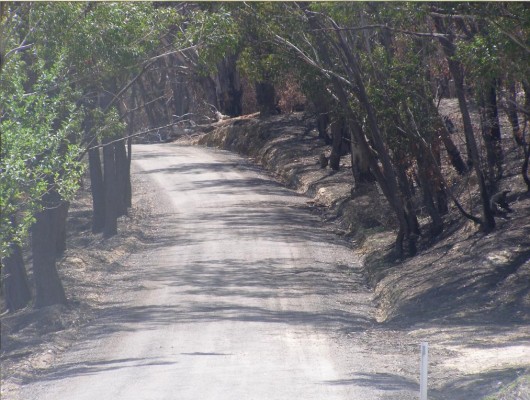 Hartley Vale Road looking east about 1km west of the village of Hartley Vale.
Observe the right (south side) and the consistent blackened ground and blackened tree bases, clear evidence of ground level hazard reduction /backburning.
Compare this to the left unburnt side. It was this Hazard Reduction/Backburn on Sunday 12th November 2006 (or thereabouts) that escaped control and incinerated the treetops up slope and which crossed over the Darling Causeway into the Blue Mountains National Park and ultimately down into the Grose Valley on 23rd November 2006.
[Photo by Editor, 20070204, Photo © under ^Creative Commons] Hartley Vale Road looking east about 1km west of the village of Hartley Vale.
Observe the right (south side) and the consistent blackened ground and blackened tree bases, clear evidence of ground level hazard reduction /backburning.
Compare this to the left unburnt side. It was this Hazard Reduction/Backburn on Sunday 12th November 2006 (or thereabouts) that escaped control and incinerated the treetops up slope and which crossed over the Darling Causeway into the Blue Mountains National Park and ultimately down into the Grose Valley on 23rd November 2006.
[Photo by Editor, 20070204, Photo © under ^Creative Commons]
.
Mr Debus said that while fire fighting authorities are preparing themselves to be ready as possible for flare ups and major fires, home-owners in fire-prone areas of the Blue Mountains should also be readying themselves for the approaching season. [Ed: Famous last words]
“Now is the time to start cleaning gutters, ember-proof houses and sheds, prepare fire breaks and clear grass and fuel away from structures.” he said. [Ed: Such was the least of the bushfire risks when the Parks Service and RFS were actively and recklessly setting fire to bushland].
.
[Source: ‘Fire Crews Prepare’, 20060920, Blue Mountains Gazette, print]
.
Tags: Blue Mountains National Park, Blue Mountains World Heritage Area, bushfire causes, Darling Causeway, Escaped Controlled Burn, Grose Valley Fires 2006, Hartley Vale Road, hazard reduction, national parks, NPWS, prescribed burning
Posted in Blue Mountains (AU), Threats from Bushfire | No Comments »
Add this post to Del.icio.us - Digg
Saturday, May 11th, 2013
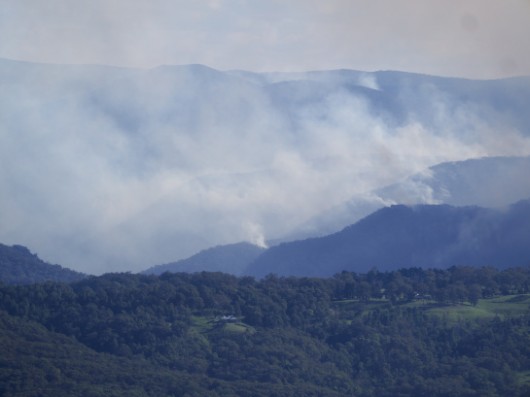 Aerial Arson of Mt Cronje
(A recent example of aerial arson to the Blue Mountains World Heritage) Aerial Arson of Mt Cronje
(A recent example of aerial arson to the Blue Mountains World Heritage)
.
Once again across the Greater Blue Mountains World Heritage Area, smoke blocks out the horizon.
Once again the custodian of the natural values of the World Heritage Area has set fire to it in the middle of wilderness, over 15km from the nearest human habitation.
The New South Wales National Parks and Wildlife Service (NPWS) Regional Manager, a Mr Geoff Luscombe, is proud of his widespread lighting of natural vegetation in as part of the cult of ‘Hazard Reduction‘.
On this occasion some 5,640 heactares of wilderness vegetation in the remote Wild Dog Mountains of the southern Blue Mountains National Park was targeted as a hazard.
This wild wilderness region is wholly within the internationally protected Greater Blue Mountains World Heritage Area. And so we have wolves managing the chickens.
It was a hazard because it hadn’t been burnt for many years, perhaps 20 years, so according to hazard cult orthodoxy, unburnt bushland asked for it and so had to be burnt. No concern for native fauna was made and no concern for fire sensitive flora was made. Such values are condemned as fuel hazards.
.
 The Tigerquoll (Dasyurus maculatus)
A rare and threatened top order predator of the Blue Mountains
The Tigerquoll (Dasyurus maculatus)
A rare and threatened top order predator of the Blue Mountains
.
Like in the Vietnam War, the choppers were called in with aerial incendary to set fire indiscriminately to all wilderness below and to its world heritage values.
.
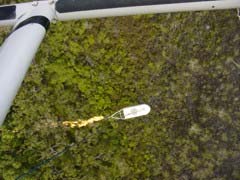 Aerial incendiary dropped from helicopter in National Park wilderness Aerial incendiary dropped from helicopter in National Park wilderness
.
So the NPWS set fire to the vast wilderness area way south of Jamison Valley, way south of Mount Solitary and south of Cedar Valley beyond – between Green Gully, Cox’s River, Narrow Neck and the remote Wild Dog Mountains.
Hazard reduction for whose perverted gratification, and to benefit whom?
And Luscombe boasted that the Wild Dog West burn will be the largest burn undertaken in Blue Mountains National Park for many years.
Once underway, the Wild Dog Mountains burn will affect the following locations:
- Green Gully picnic and camping areas (Dunphy’s Camp) will be closed during and after the operation
- Wild Dog Mountains, the Kanangra to Katoomba track, Splendor Rock, Yellow Dog track, Blue Dog track, Breakfast Creek track, Carlons Head off Narrow Neck Bell Bird Ridge track and the Cox’s River south of Breakfast Creek
.
Since 1st July 2012 the NPWS has completed more than 210 burns totalling more than 110,000 hectares – our largest ever Hazard Reduction Programme. This is more than 65% of all hazard reduction carried out in NSW during the period, despite NPWS managing just 25% of the state’s fire prone land.
This hazard reduction burn is part of the NSW Government’s $62.5 million package to boost bushfire preparedness and double hazard reduction in the state’s national parks over where conditions allow.
.
[Source: ‘Hazard Reduction Burn proposed for Wild Dog Mountains’, 20130501, New South Wales National Parks Service, ^http://www.environment.nsw.gov.au/media/OEHMedia13050102.htm]
.
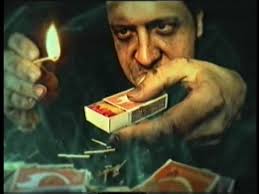 $62.5 million is going to setting fire to Blue Mountains World Heritage
How much or little goes to protecting endangered wildlife and their Recovery Plans?
Zilch across the Blue Mountains? $62.5 million is going to setting fire to Blue Mountains World Heritage
How much or little goes to protecting endangered wildlife and their Recovery Plans?
Zilch across the Blue Mountains?
.
Perhaps this National Parks Report from 2007 in the Blue Mountains, which is probably sitting on some dusty NPWS shelf, may ring a bell for our Mr Luscombe.
Do the recognised practices of “mosaic burning” and “retaining fauna habitats in a long unburnt state” have any meaning in National Parks management?
.
.
Tags: Blue Mountains, Fauna of the Blue Mountains Special Areas, Geoff Luscombe, Greater Blue Mountains World Heritage Area, hazard cult orthodoxy, hazard reduction, Hazard Reduction Programme, Helicopter Aerial Incendiary, NPWS, playing with matches, tigerquoll, Wild Dog Mountains
Posted in Blue Mountains (AU), Threats from Bushfire | No Comments »
Add this post to Del.icio.us - Digg
Tuesday, April 23rd, 2013
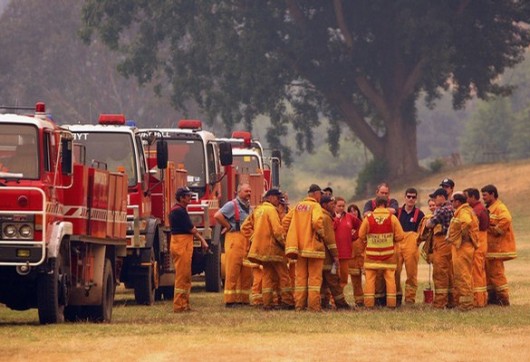 Emergency Services men and women, some paid, most unpaid;
put themselves in harm’s way in dedicated service to our country Emergency Services men and women, some paid, most unpaid;
put themselves in harm’s way in dedicated service to our country
.
.
Emergency Services serve our Country
.
<<The role of a firefighter in today’s society – be it urban, rural, natural environment, volunteer, career, industrial, defence force, aviation, motor sport, or other is one of dedication, commitment and sacrifice – no matter what country we reside and work in. In the fire service we fight together against one common enemy – fire – no matter what country we come from, what uniform we wear or what language we speak.>>
~ Lt JJ Edmondson, 1999
.
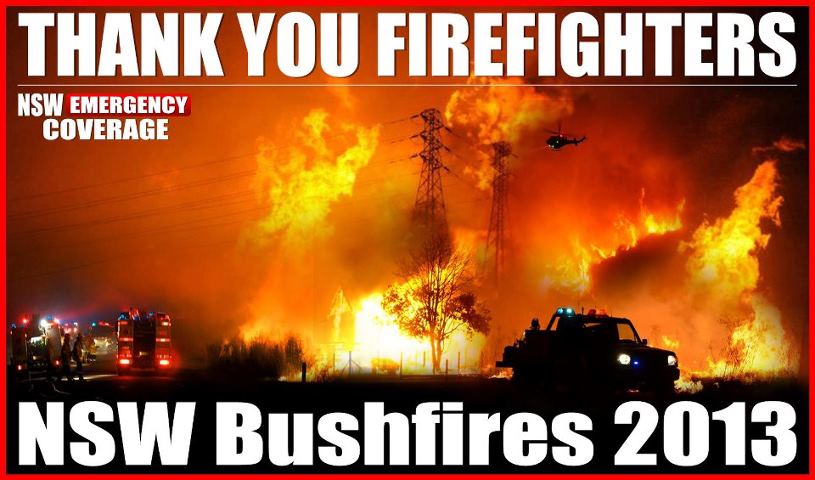
.
<<Firefighters dedicate their lives to the protection of life and property. Sometimes that dedication is in the form of countless hours volunteered over many years, in others it is many selfless years working in the industry. In all cases it risks the ultimate sacrifice of a firefighter’s life.
International Firefighters’ Day (IFFD) is a time where the world’s community can recognise and honour the sacrifices that firefighters make to ensure that their communities and environment are as safe as possible. It is also a day in which current and past firefighters can be thanked for their contributions.
International Firefighters’ Day is observed each year on 4th May. On this date you are invited to remember the past firefighters who have died while serving our community or dedicated their lives to protecting the safety of us all. At the same time, we can show our support and appreciation to the firefighters world wide who continue to protect us so well throughout the year.>>

^http://www.firefightersday.org/
.
Across Australia, the vital life-saving job of Civil Emergency Services (an umbrella term) extends beyond the professionally paid urban fire brigades.
Over decades, the task of emergency service has evolved on a state basis to include multiple independent agencies including the various rural firefighting services, ambulance services, State Emergency Services, emergency rescue services, police and their associated rescue services, helicopter rescue services such as Careflight, St John Ambulance Service and the Australian Volunteer Coast Guard, Surf Life Saving, amongst others.
Most of these agencies rely in the most part upon volunteers from the community prepared to sacrifice their time and lives for their country to help and save others in distress.
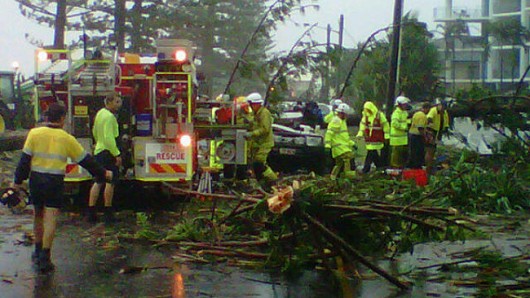 Emergency Services respond to a tornado hitting Bargara, coastal Queensland
Australia Day 2013 Emergency Services respond to a tornado hitting Bargara, coastal Queensland
Australia Day 2013
.
Emergency Services forced to rely on public charity
.
<<While Australia is one of the most bush-fire prone countries in the world, its fire-fighting services are organised on a state-by-state basis and rely heavily on thousands of unpaid volunteers. Over the past year, the seriously under-funded and under-equipped services, both professional and voluntary, have been subjected to systematic cutbacks.
The cuts, which have eroded fire and emergency services capacities, are part of ongoing reductions to vital social services—health, education and welfare—by federal Labor government and state Liberal governments.
Currently there are just over 13,000 full-time fire fighters in Australia, with more than 219,000 unpaid volunteers, drawn from local communities. The NSW Rural Fire Service (RFS), the largest agency, has a volunteer base of over 70,000 and operates more than 7,000 vehicles.
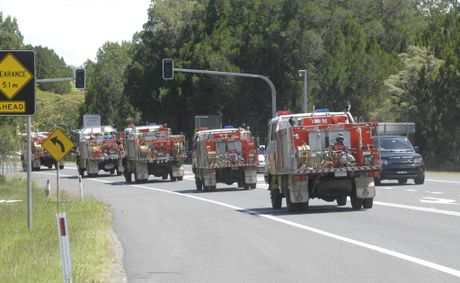
NSW Emergency Services Minister Michael Gallagher acknowledged last year that the current summer bushfire season had “the potential to be one of the worst in years.” Yet, the state Liberal government, following on from the previous Labor government reductions, announced in last year’s budget that it was slashing staff funding to the RFS by $11.7 million over four years. The move is expected to axe at least 120 jobs, or 1 in 8 full-time positions.
The state government also wound back the Rural Fire Fighting Fund, which helps pay for a range of RFS operations, by $8 million—from $271 million to $263 million for 2012-2013. In addition, it is cutting NSW Fire and Emergency, which employs most of the state’s full-time fire-fighters, by $70 million over the next four years.
According to a recent review by the NSW auditor-general, total funding for the RFS has been reduced by almost 7% and the number of fire-fighting tankers supplied or refurbished has decreased from 216 to 177 during the past two years.
Similar cuts have been imposed by the Victorian state government on the Country Fire Authority (CFA). The CFA currently has a 44,000-strong volunteer base, down from 83,000 in 1998.
Last year, the Victorian Liberal government announced it would axe $66 million from its fire services budget—$41 million from the CFA and $25 million from the Metropolitan Fire Brigade. Fifty paid CFA positions were also eliminated during the year, as a result of earlier budget decisions.
A recent CFA newsletter said the organisation would have to “reduce and defer building maintenance, reduce funds available for volunteer uniform expenditure,” manage volunteer recruitment and “encourage those brigades capable of doing so to fully fund their own initiatives.”
These cutbacks have been imposed despite Victoria’s catastrophic 2009 Black Saturday bushfires, which killed 173 people, including 23 children, and incinerated 450,000 hectares and 2,100 homes. Political responsibility for this heavy loss of life lies with the previous state Labor government of Premier John Brumby. Its so-called “stay or go” policy and other cost-cutting measures encouraged individuals to devise their own fire response plans and attempt to defend their homes when faced with approaching infernos.

A royal commission made limited criticisms and issued 67 recommendations to improve fire safety. More than two years after it handed down its final report, only 35 of the recommendations have been implemented. Less than 360 out of 850 fire trucks have received recommended fire safety upgrades and only one fire refuge is operational.
The Victorian government’s claims to have improved emergency communications were exposed on the first day of this month’s heatwave when the emergency web site crashed. The web site received 700 hits a second, double the level planned for by the CFA and state government.
Similar cuts are being imposed in other states. Up to 20 administrative positions are being slashed from the Queensland Rural Fire Service, and 18 full-time jobs from the Tasmanian Fire Services. In Western Australia, the Fire and Emergency Service Authority is not filling vacant positions and has been directed by the state government to reduce operating costs by almost $400,000 during the current financial year.
None of these measures, or the previous years of gross under-funding by Liberal and Labor state governments alike, would have been possible without the political assistance provided by the two principal unions—the United Firefighters Union and the Fire Brigade Employees Union—that cover most professional fire-fighters.
Opposed to any national mobilisation of fire fighters, the unions have worked to dissipate their members’ concerns with harmless protests, while appealing to the various state administrations to negotiate cost-cutting and productivity deals. Fire union protests last year in Sydney and Melbourne attempted to promote illusions in the return of state Labor governments—that is, the same party that was responsible for the previous rounds of cutbacks.>>
[Source: ‘Australian fire-fighting budget cuts place lives at risk’, 20130119, by Mark Church, ^http://www.wsws.org/en/articles/2013/01/19/bush-j19.html]
.
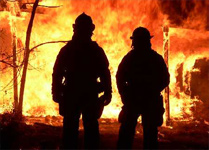
While governments always manage to find millions and billions for “other priorities”, our Emergency Services are forced to rely on the goodwill and charity of local communities to maintain basic operational expenses.
That the men and women who volunteer their time and put their lives on the line to respond when disaster strikes, also have to fundraise their service is a damning indictment of our governments’ abrogated duty of care to protect life and property. Annual doorknock appeals and sausage sizzles are not the way to fund Emergency Services. What are our taxes paid for?
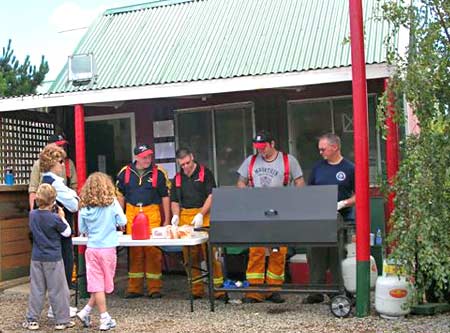 CFA Sausage Sizzle CFA Sausage Sizzle
.
Psychological Trauma eating away at Emergency Services
.
<<A hidden toll of psychological trauma among Victorian firefighters may be leading to suicide, alcohol abuse and depression.
A report by the University of Newcastle’s Centre of Full Employment and Equity also reveals firefighters’ biggest stress is their role as a first responder to medical emergencies and that some believe they are not getting adequate support. The report, written by research professor William Mitchell and research fellow Beth Cook and commissioned by the firefighters’ union, was released to the public on Monday 18th February 2013.
It comes days before the Auditor-General releases a report expected to show high rates of unplanned leave by professional firefighters (see below).
The University of Newcastle’s report warns that:
”given the psychological impact of firefighting – higher prevalence of PTSD [post-traumatic stress disorder], depression, anxiety and alcohol or drug use – there is a probability that firefighters may be more likely to commit suicide”.
Firefighters union secretary Peter Marshall said the report – including figures from one study showing 68% of firefighters recorded moderate symptoms of PTSD – revealed firefighters were sitting on a ”ticking psychological time bomb”.
He said existing support programs, which include a peer-to-peer service, were inadequate and budget cuts to the metropolitan and country fires services had exacerbated the problem.
.
”The government is drawing on the physical and mental reserves of firefighters like never before but not giving them the support.”
.
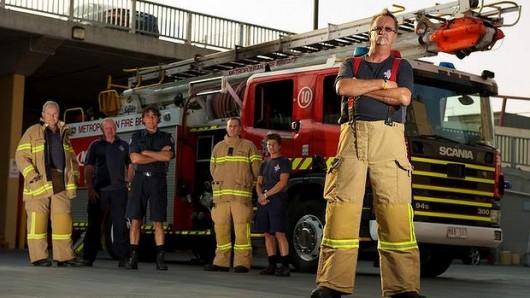 MFB Firefighter Danny Ward supported by his colleagues
(Photo by Wayne Taylor) MFB Firefighter Danny Ward supported by his colleagues
(Photo by Wayne Taylor)
.
But a spokesman for Deputy Premier and Emergency Services Minister Peter Ryan said ”this year’s fire services budget was the second-biggest on record, surpassed only by last year’s budget”, which paid for many of the bushfire royal commission recommendations. The spokesman said the government would wait to read the union-commissioned study before it responded.
The Metropolitan Fire Brigade’s chief officer, Shane Wright, stressed that existing support programs were comprehensive and effective. Mr Wright also said that, compared with other emergency services, firefighters had smaller incidences of stress-related WorkCover leave.
Metropolitan firefighters interviewed for the report singled out stress factors including ”the introduction [in 2000] of Emergency Medical Response [in which firefighters are first respondents to medical emergencies] and the ageing of the workforce in the MFB”, while professional CFA firefighters ”singled out the deterioration in the numbers and reliability of volunteers as the single most notable change for the organisation”.
Asked to rank their most stressful incidents, metropolitan firefighters listed fire fatalities and dealing with seriously injured children or the sudden death of an infant.
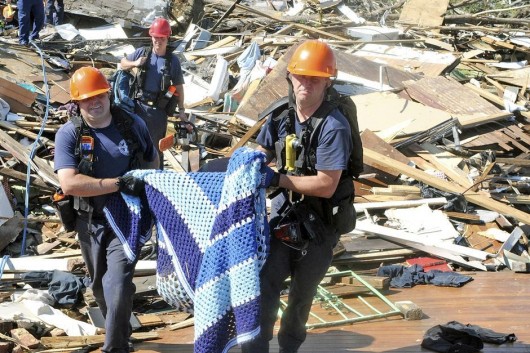 Burmingham Fire and Rescue
(this was a dog, but it gets a whole lot worse) Burmingham Fire and Rescue
(this was a dog, but it gets a whole lot worse)
.
The report states:
”Participants were concerned that the intensity and level of exposure increased over time and left all firefighters vulnerable to PTSD as their career progressed, and even after retirement, when they lost the support of co-workers. Some participants expressed a belief that many firefighters suffered from undiagnosed PTSD or depression.”
.
The focus groups also reported perceived insufficient support from management to deal with stress. However, the study also noted firefighters were often reluctant to seek help, sometimes preferring to self-medicate with alcohol, and that the existing data around stress levels was incomplete.
A 30-year firefighting veteran, Danny Ward, told Fairfax Media that while he and his colleagues were well trained to deal with fires, they are not sufficiently supported to deal with the mental impact of attending car accidents, cot deaths, heart attacks and drug overdoses.
.
”You don’t tell the kids and wives about the day that you’ve had. You just go upstairs and lie in bed,” Mr Ward said. ”The PTSD problem is just waiting to explode.”
.
[Source: ‘Report reveals personal toll on firefighters’, 20130218, by Nick McKenzie and Richard Baker, ^http://www.theage.com.au/victoria/report-reveals-personal-toll-on-firefighters-20130217-2elcb.html]
.
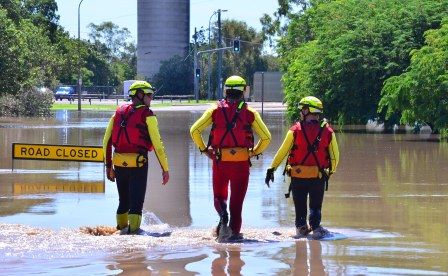
.
Trauma Report Extract:
.
<<Firefighters have one of the most dangerous jobs in the world and suffer high levels of physical and psychological injury, according to a study by a research unit of the University of Newcastle. Researchers examined international and Australian health studies and interviewed local firefighters. They found that the changing role of firefighting is having a big impact on the health of career firefighters and volunteers.
Fires are not the only issue. Firefighters are also concerned at the stress of dealing with emergency medical response (EMR), suicides, drug incidents, traumatic events involving children such as SIDS, increased violence, and the threat of terrorism. Firefighters are found to have increased levels of Post Traumatic Stress Disorder (PTSD) and other illnesses.
Firefighting differs from other emergency services they get the heavy jobs, the ‘dirty’ and dangerous jobs, and are often first on scene. These risks cannot be mitigated. It is the nature of the job. Firefighters go into danger, as others flee.
“Firefighters are exposed to greater stresses than other workers even if management undertake the most extensive risk management.” (Report page 33)
The pressure of budget cuts to fire service s is also impacting on the stress levels of firefighters.
Organisational stressors include inadequate staff, and a lack of communication and consultation.
Firefighters one of the fittest sectors of the workforce when they begin their career suffer above average rates of cancers, heart attacks, chemical and asbestos exposure, PTSD, and other risks.
They often keep their concerns to themselves, and some take to self medication through alcohol and other drugs. The increased fitness of the workforce when they begin their firefighting career also helps mask health issues (the healthy worker effect).
Support services have not kept pace with the changing role of firefighters. Management may view its support programs as successful, but often the reality is otherwise. Management is disconnected from the workers on the fire ground. In the CFA, peer support personnel are predominantly volunteers with less incident experience than fulltime firefighters.
The hidden cost of these physical and psychological injuries falls on the firefighters, family, fire services and communities, as firefighters are self medicating, taking unplanned time off to recover and going untreated as they do not have access to adequate support to address the root causes.
Increasingly firefighters are using such coping mechanisms to mask the true effect of the acute and accumulated exposure that they are confronted with in the workplace. There is a high cost to the individuals concerned, their families, and the fire services which employ them.>>
.
[Source: ‘Occupational health effects for firefighters: The extent and implications of physical and psychological injuries‘ (Synopsis), a report by The Centre of Full Employment and Equity (CofFEE) (a research unit of the University of Newcastle), February 2013, commissioned by the United Firefighters Union of Australia, Victorian Branch,^http://www.firecrisis.com.au/wp-content/uploads/2013/02/CofFEE-report-synopsis.pdf]
.
.
.
.
Let Emergency Services march with Diggers on ANZAC Day
.
An ex-Vietnam vet and currently a politician in New South Wales, Charlie Lynn, has broken ranks to urge his ‘‘mates’’ in the leadership of the Returned and Services League (RSL) to recognise the dedicated, courageous and honourable service of emergency services personnel by welcoming them to march on Anzac Day.
.
“They stand bravely in the path of fire, risking their lives for mate and country – just like a soldier.”
.
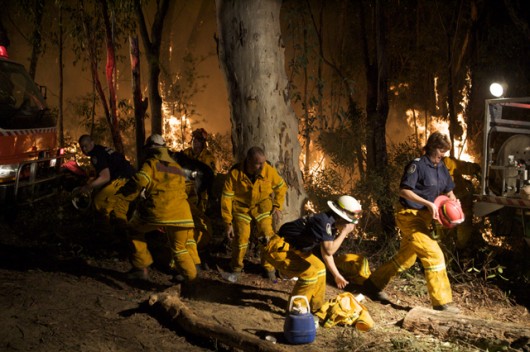 Volunteer Fire Fighters Association Volunteer Fire Fighters Association
.
Now a member of the state government and a war veteran, Charlie Lynn, says Rural Fire Service (RFS) and State Emergency Service (SES) volunteers should be given the honour of marching on Anzac Day.
Mr Lynn, a Liberal Party MP who served in Vietnam, has broken ranks to urge his ”mates” in the leadership of the RSL to consider broadening the scope of Australia’s sacred military day.
”I’ve been thinking about what Anzac represents, and to me it’s about selfless service to the nation and sacrifice,” Mr Lynne said.
 People in the ANZAC Day march as it marches down George St, Sydney. People in the ANZAC Day march as it marches down George St, Sydney.
(Photo by Tamara Dean)
.
‘RFS and SES volunteers give up days and weeks of their time to train and be prepared then they risk their lives at times of extreme danger like we’ve seen over the past week. To me that’s the same sort of sacrifice that soldiers make.”
Mr Lynn said the inclusion of volunteers from outside military ranks would breathe new life into Anzac Day marches in country towns where numbers of war veterans have waned.
”Anzac Day numbers are declining rapidly. We’re not seeing the bulk numbers marching like we did after Word War I and World War II, and something will need to be done to keep it alive,” he said. ”Virtually every town in Australia has an RFS, an SES and a war memorial. That’s what makes us unique. This would be a way to bring all those together and keep the spirit of Anzac Day alive and keep people actively participating in it rather than being spectators.”
But Mr Lynn, who has guided more than 60 groups along the Kokoda Track, knows he has a fight on his hands to convince Don Rowe, the NSW president of the RSL.
Mr Rowe said he would have a ”big problem” with allowing non-services personnel and their descendants into the main Sydney march but would consider greater involvement of volunteers in rural areas.
”We’ve got a set of guidelines and there is no talk of changing them. Anzac Day and the march is for people who have served in our defence forces. It’s about them.”
Mr Rowe said 20,000 people marched and the number was rising due to more descendants marching.
RFS volunteers already helped co-ordinate marches in towns, Mr Rowe said. ”In rural areas it’s up to the sub-branches as to what level of involvement those volunteers have and that’s no problem for us but when it comes to the main march in Sydney we would have a big problem with that.”
The nation’s most famous RFS volunteer, Tony Abbott, declined to comment on the idea as he began his family holiday on Saturday.
The Premier, Barry O’Farrell, said he was cool on the idea but flagged a separate ceremony to honour the fire volunteers who have been battling bushfires across the state over the past week.
”It’s an interesting idea but my personal view is that Anzac Day should remain a day to honour those who’ve served our country in war,” he said. ”There will be appropriate acknowledgement of the efforts of emergency workers during the current fire crisis once the crisis is over.”
A spokesman for the RFS said: ”At this stage we don’t have a position on that.”
[Source: ‘Let firies march with Diggers like me on Anzac Day, says MP’, 20130113, by Heath Aston, Political Reporter, Sydney Morning Herald, ^http://www.smh.com.au/nsw/let-firies-march-with-diggers-like-me-on-anzac-day-says-mp-20130112-2cmi0.html]
.
That they do not pick up a rifle makes them no less honourable for recognition for their dedicated service to Australians and to our country.
.
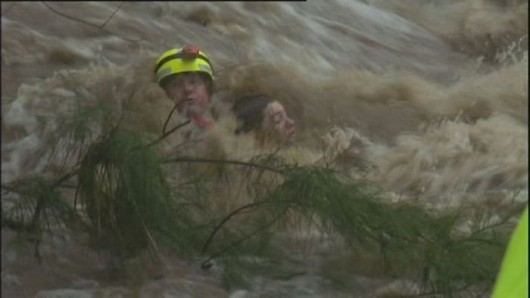 Swift Water Rescue by Emergency Services last January
Source: ‘As it happened: Tornadoes hit coastal towns’, 20130127 Swift Water Rescue by Emergency Services last January
Source: ‘As it happened: Tornadoes hit coastal towns’, 20130127
http://www.abc.net.au/news/2013-01-26/flood-havoc-as-rain-lashes-qld/4485304
.
Our taxes should also be paying these dedicated selfless souls and paying full premiums for all their personal insurances so that should tragedy occur in the line of duty, dependents will be properly cared for and shall never want for the basics of life.
It is a disgrace that governments go into hiding to avoid financial responsibilities of those who have served our country who putting themselves in harms way. Why should the public have to double dip and charities have to do the financial job of government in the financial aftermath of national emergencies?
Same same in 2009 Black Saturday, Cyclone Yasi, Brisbane Floods, Canberra Firestorm, Ash Wednesday, etc, etc, etc.
.
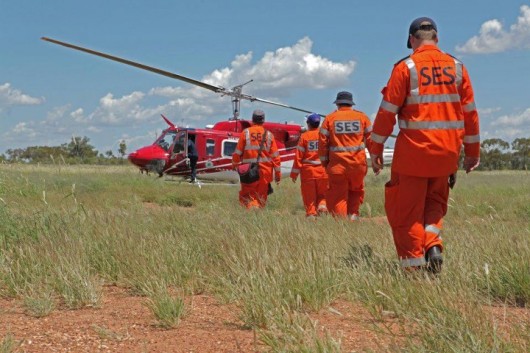 . .
Further Reading:
.
‘Management of Unplanned Leave in Emergency Services’
Tabled by the Victoria Auditor-General’s Office on 6th March 2013

.
<<Operational staff at Ambulance Victoria (AV), the Metropolitan Fire and Emergency Services Board (MFESB) and Victoria Police (VicPol) are more likely to suffer injuries and emotional stress, and have higher rates of unplanned leave, than other public sector staff.
AV, MFESB and VicPol have each recognised the importance of managing unplanned leave. However, there are significant differences in how effectively and efficiently they are each managing the issues.
Both AV and VicPol have been generally effective and efficient in managing unplanned leave, although AV recognises the need to reduce the personal unplanned leave levels of paramedics and other operational staff.
AV and VicPol have effective management oversight, supported by sound and practical data that enables their frontline managers to manage and support staff. They are aware of the causes of unplanned leave and have either implemented, or are developing actions to address these.
However, MFESB needs to improve considerably. Compared to its peer agencies it has the poorest unplanned leave performance. MFESB’s management has been aware of the causes of personal unplanned leave since 2000 but it has not adequately addressed them. There is a lack of frontline management accountability for unplanned leave, and a lack of regular data on firefighters’ unplanned leave available to managers.>>
.
March 2013: Audit Summary
.
Background
.
Victoria’s public sector provides its staff with a range of leave benefits. These benefits include annual leave, parental leave and study leave, which are typically planned in advance with the employer.
Public sector staff are also provided with personal leave benefits to manage incidents such as illness, or the need to care for an ill family member. Additionally, staff injured at work have access to worker’s compensation leave. These types of leave are typically unplanned and occur unexpectedly.
All organisations experience some degree of unplanned leave which, given its nature, can create management and budgeting challenges. Unplanned leave can create significant financial costs, disrupt service delivery and compromise the achievement of organisational objectives. Attendance at work can be affected by:
- health and fitness problems
- barriers such as caring responsibilities or personal emergencies
- motivation.
.
Excessive unplanned leave can be a symptom of larger problems within an organisation, including poor occupational health and safety management, an unfavourable organisational culture, or insufficient controls over access to entitlements such as sick and carer’s leave. Operational staff in emergency services agencies, such as Ambulance Victoria (AV), the Metropolitan Fire and Emergency Services Board (MFESB) and Victoria Police (VicPol) are more likely to suffer injuries and emotional stress compared to their non-operational counterparts due to their high-risk work environment.
.
Conclusions
.
Victoria’s emergency service agencies—AV, MFESB and VicPol—have each recognised the importance of managing unplanned leave. However, there are significant differences in how effectively and efficiently they are each managing the issues.
Both AV and VicPol have been generally effective and efficient in managing unplanned leave, although AV recognises the need to reduce the personal unplanned leave levels of paramedics and other operational staff. AV and VicPol have effective management oversight, supported by sound and practical data that enables their frontline managers to manage and support staff. They are aware of the causes of unplanned leave and have either implemented, or are developing actions to address these.
However, MFESB needs to improve considerably. Compared to its peer agencies it has the poorest unplanned leave performance, which has been caused by ineffective management over the past decade.
MFESB’s management has been aware of the causes of personal unplanned leave since 2000 but it has not adequately addressed them. There is a lack of frontline management accountability for unplanned leave, and a lack of regular data on firefighters’ unplanned leave for managers at the station level. This needs to be addressed as a matter of priority.
.
Findings
.
Unplanned leave performance
In 2011–12, the number of shifts lost due to unplanned leave for operational staff at AV, MFESB and VicPol was 10.6, 11.6 and 9.6 per full-time equivalent (FTE) respectively.
Long average shift durations at AV and MFESB—11.77 hours and 12 hours—result in average time lost to unplanned leave of 124.6 hours and 139.5 hours per FTE respectively. VicPol’s shorter average shift length of 7.6 hours results in time lost to unplanned leave of 72.9 hours per FTE.
The level of unplanned leave at AV reflects a slight decline compared to 2010–11. While MFESB achieved a slight reduction in 2011–12, its unplanned leave has increased steadily since 2000. Unplanned leave for VicPol has remained constant and substantially below AV and MFESB.
.
Senior agency management oversight
Effective management of unplanned leave relies on the commitment and oversight of senior management. Senior managers set expectations by establishing policies, practices and the responsibilities of staff and managers. Sustained management attention is required to effectively identify and address the underlying causes of unplanned leave.
Each agency’s senior management is briefed on the types and levels of unplanned leave and the contributing factors, however the nature and extent of oversight and effective action varies.
Both AV’s and MFESB’s senior management regularly consider unplanned leave. AV’s senior management receives regular information on unplanned leave and enforces responsibilities at all levels of operational management. However, MFESB’s senior management has only strengthened its oversight of unplanned leave since 2010, and this has delayed its response to the issues it faces.
VicPol conducts reviews of operational groups every six months. These reviews provide senior executives with the opportunity to examine police managers’ operational performance and request specific action, including managing unplanned leave. However, the frequency of these reviews may limit VicPol’s ability to respond to systemic unplanned leave issues in a timely way.
.
Industrial constraints on decision-making
MFESB and the United Firefighters’ Union (UFU) entered into an enterprise agreement for firefighters in 2010. The agreement is legally binding on MFESB and UFU. It contains provisions that constrain MFESB’s ability to effectively and efficiently implement initiatives to manage unplanned leave.
The provisions in the enterprise agreement effectively require that any change affecting MFESB’s relationship with its staff be agreed upon with UFU. This has the potential to contribute to difficulty and delay in introducing reasonable mechanisms to hold firefighters, and their managers, accountable for personal unplanned leave that is not justified by illness or injury.
.
Identifying the causes and impacts of unplanned leave
Identifying the causes of unplanned leave provides agency management with the information it needs to develop appropriate responses. All agencies have undertaken work to identify the causes and impacts of unplanned leave, although the extent to which this has informed management actions varies.
AV, MFESB and VicPol all regularly monitor service levels, overtime costs and unplanned leave to identify trends and patterns that may point to local causes of unplanned leave. In addition, MFESB has commissioned two reviews to gain a greater insight into the causes of personal unplanned leave.
However, only AV and VicPol have taken effective action to address the underlying causes of unplanned leave. While MFESB has had the necessary information over the past decade, it has not taken appropriate action until recently.
.
Frontline management practices
Effective frontline management is a key part of unplanned leave management. Frontline managers are in a position to positively influence motivation, reinforce staff understanding of their responsibilities, and deal directly with staff taking high levels of personal unplanned leave.
.
Frontline management of unplanned leave
Frontline management of unplanned leave is sound at both AV and VicPol, with clear responsibilities for managing personal unplanned leave, and generally consistent follow-up with staff after periods of unplanned leave.
AV faces challenges embedding good practices in rural branches where team managers are primarily allocated to paramedic duties but also have a significant number of staff to manage. The importance of enabling these managers to better manage their staff is highlighted by the rate of personal unplanned leave in AV’s rural areas, which exceeded that in metropolitan areas by 2.6 shifts per full-time operational staff member in 2011–12.
In contrast, MFESB’s commanders have primary responsibility for managing unplanned leave but do not have direct relationships with their firefighters. This limits their capacity to effectively work with firefighters to address personal unplanned leave issues. While senior station officers and station officers are in the best position to manage unplanned leave, they do not play an active role in doing so.
.
Accountability of frontline managers
To effectively perform the role of a frontline manager, accountability for managing unplanned leave should be clear and managers should have access to support, advice and appropriate professional development. Accountability was strongest at both AV and VicPol, and again was weakest in MFESB.
AV’s team managers have primary responsibility for managing the unplanned leave of operational staff. Line management practices include regular reviews of unplanned leave and the actions of managers to address individual cases. Managers’ performance plans and appraisals reinforce their responsibility for effectively managing unplanned leave.
VicPol places responsibility for unplanned leave with senior sergeants who manage police stations. As with AV, line management practices include regular monitoring of unplanned leave, with senior sergeants expected to closely monitor cases of high unplanned leave.
MFESB is strengthening the role of firefighter commanders for managing unplanned leave. However, MFESB has not established the means to hold commanders, senior station officers or station officers, who manage individual fire stations, accountable for the unplanned leave of their teams.
.
Services and guidance for frontline management
The causes of unplanned leave are complex and managing it can be equally complex. Access to robust guidance and assistance from human resource experts is essential in providing effective management responses.
Frontline managers at AV and VicPol are well supported with advice on human resource management matters and unplanned leave data. This enables managers to confidently deal with staff issues in compliance with organisational policies.
However, MFESB does not have sufficient internal human resources expertise to assist managers to confidently interpret the firefighters’ enterprise agreement and handle staff matters in MFESB’s industrial relations environment. Further, it does not provide its frontline managers with data on the unplanned leave of individual firefighters. This is a significant weakness in MFESB’s approach to managing unplanned leave.
.
Human resource policies and processes
Effective management of unplanned leave requires agencies having clear policies and procedures that are regularly communicated, monitored and applied. Processes and systems for managing shift work should have the ability to respond to changes in staff availability, including changes resulting from unplanned leave.
.
Staff responsibilities
Each agency has sound procedures for recording and approving unplanned leave. However, the extent to which these procedures are effectively implemented varies across the agencies. Ineffective implementation diminishes the purpose and value of having these controls in place, and does little to encourage staff to account for their absences, or to deter discretionary unplanned leave.
AV has generally sound procedures for reporting and recording unplanned leave. AV’s operational staff are required to contact one of two state duty managers so that unplanned leave can be recorded and replacement staff rostered. Unplanned leave is initially recorded as ‘uncertified’ and is only changed after staff submit evidence to support the absence.
MFESB has two inconsistent sources of information for firefighters on the requirements for reporting and recording unplanned leave. In addition, MFESB’s procedures for validating evidence to justify unplanned leave are unreliable. Documentary evidence supporting unplanned leave recorded as ‘certified’ was not held on MFESB’s personnel files in 23 per cent of instances involving firefighters with high levels of unplanned leave. MFESB does not apply controls to reinforce staff members’ responsibility for providing evidence in support of unplanned leave.
VicPol has a consistent approach to reporting and recording unplanned leave. VicPol policy only requires that managers sight evidence of unplanned leave, rather than retain copies of evidence. While this creates some risk of inconsistency in applying procedures, VicPol has adequate controls that compensate for this risk.
.
Operational resource management
AV’s systems and processes for operational resource planning and management provide the capacity for AV to reduce the factors causing unplanned leave. It has thorough processes for planning the resources it requires to deliver ambulance services. AV has centralised call-taking and dispatch, and has recently introduced a statewide rostering system that provides for the efficient deployment of ambulance resources. However, central controls over rostering, while improving the efficiency of operational staff management, have reduced the flexibility previously available to staff in rural regions. Team managers report that this contributes to unplanned leave.
MFESB and VicPol management are aware of the need to improve rostering and are taking steps to address weaknesses. VicPol’s rostering is conducted on a station‑by‑station basis with effectiveness dependent on the officer managing the roster. The lack of centralised controls over rostering and the large number of individual worksites create the risk that poor rostering contributes to unplanned leave. As part of its planned corporate actions for 2012–15 VicPol is conducting a trial of practices to improve aspects of rostering. Contingent on the outcomes of the trial, VicPol will consider wider application of the practices.
MFESB is working to improve the operational management of firefighters to reduce the costs arising from unplanned leave. However, the extent to which it is able to manage these costs is limited by a provision in the firefighters’ enterprise agreement that specifies the minimum number of firefighters required for each shift. As unplanned leave and the transfer of firefighters into training and special projects reduce the number of rostered firefighters available to work, firefighters must be recalled to work overtime in order to meet the minimum number required.
.
Initiatives to reduce unplanned leave
AV has been proactive in developing initiatives that address unplanned leave but has been slow to extend these initiatives to all parts of the organisation. Between 2007 and 2011, AV successfully implemented alternative arrangements that strengthened the capacity of frontline managers of large teams to lead, manage and support paramedics and other operational staff.
While AV also provided development training for managers of smaller non-metropolitan teams, comprehensive development for these team managers has been delayed until 2012–13 because of financial constraints. This delay is likely to have contributed to the difficulty of reducing the level of unplanned leave in rural areas, which remains higher than in metropolitan locations.
MFESB is also committed to developing its firefighter managers’ leadership and management skills, so as to increase firefighters’ commitment to MFESB’s strategic goals, and reduce their personal unplanned leave.
AV, MFESB and VicPol have embarked on strategies to reduce workplace injury. AV is concentrating on reducing the incidence of the two largest sources of claims—manual handling and psychological stress. Lifting equipment will be provided in 2012–13 and individual psychological plans for 1 000 operational staff are to be completed by June 2013.
MFESB is focusing on strengthening the physical resilience of firefighters, recognising that approximately 60 per cent of its WorkCover claims result from manual handling, slips and falls. MFESB is also placing emphasis on firefighters’ health awareness as 60 per cent of its firefighters are aged over 45 years.
Similarly, VicPol has given a high priority to reducing workplace injury, with claims declining by 40 per cent between 2006–07 and 2011–12. However, psychological injuries that generally involve longer-term absences have declined at around two-thirds the rate of all workplace injury claims.
VicPol has a strategy to address these issues, part of which is the development of frontline managers whose role includes identifying and intervening when staff show indications of psychological stress, including unusual levels of unplanned leave.
.
Recommendations
.
Ambulance Victoria should:
.
- Review support for team managers who also perform paramedic duties and implement improvements to maximise team managers’ ability to perform their roles
- Review processes for managing personal unplanned leave evidence to reduce the risk that personal unplanned leave is incorrectly recorded
- Closely monitor in rural regions the outcomes of its strategy to strengthen team management and adjust the strategy to address gaps or underperformance.
.
The Metropolitan Fire and Emergency Services Board should:
.
- Review the impact of its enterprise agreements on the efficiency of frontline management, and on the implementation of audit recommendations, in preparation for enterprise agreement discussions in 2013
- Strengthen performance management of firefighter managers and reduce the financial disincentive to more effectively manage personal unplanned leave
- Provide operational commanders, senior station officers and station officers with regularly updated information on the personal unplanned leave of firefighters in their teams
- Improve specialised human resources support to frontline managers
- Provide one comprehensive source of information on policies and procedures for managing personal unplanned leave
- Review and strengthen controls over staff fulfilling their responsibilities for providing evidence to support personal unplanned leave
- Continue to strengthen human resource management processes and controls to reduce avoidable overtime costs.
.
Victoria Police should:
.
- Improve the management of police members undergoing performance and discipline procedures
- Monitor the use of online tools for accessing unplanned leave data, to make sure that the tools are accessible and meet the needs of police managers
- Adequately train all frontline police managers to handle complex personal matters involving staff.
.
[Source: Victoria Auditor-General’s Office, ^http://www.audit.vic.gov.au/reports_and_publications/latest_reports/2012-13/20130306-unplanned-leave.aspx]
.
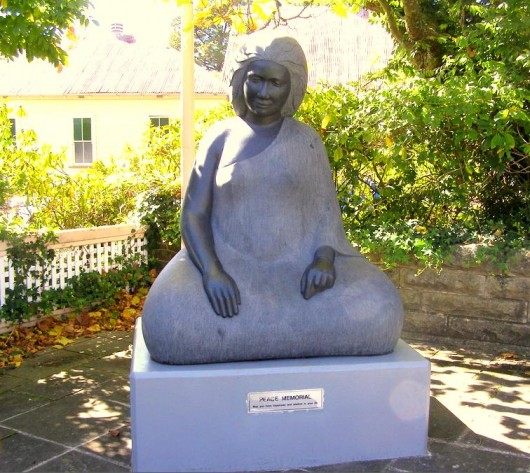 Peace Memorial
Enscription: “May you have happiness and wisdom in your life”
[by Artist, Tom Coley, who has long meditated to try to understand what peace means,
borne out of his childhood experiences during the London Blitz] Peace Memorial
Enscription: “May you have happiness and wisdom in your life”
[by Artist, Tom Coley, who has long meditated to try to understand what peace means,
borne out of his childhood experiences during the London Blitz]
.
Footnote
.
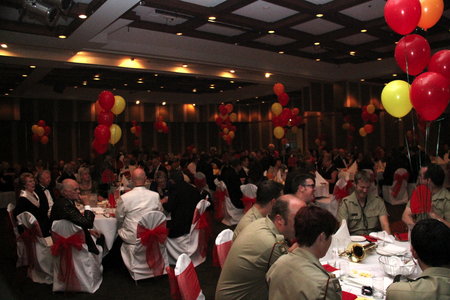 Rural Fire Service Red Balloon Ball fundraiser Rural Fire Service Red Balloon Ball fundraiser
.
April 2013:
.
<<The Blue Mountains community will receive bushfire safety messages quicker when the Blue Mountaims Rural Fires Service (RFS) implements a text messaging system and other technology, thanks to money raised at a tourism function.
About 120 industry, RFS and communty members attended the annual Blue Mountains Lithgow and Oberon Tourism (BMLOT) Red Balloon RFS Ball at the Fairmont Resort Leura on April 5.
More than $20,000 was raised through a Pick-a-Box raffle draw and a live auction with prizes including restaurant dinners, overnight stays and luxury items donated by tourism operators throughout the Blue Mountains, Lithgow and Oberon region…
Blue Mountains RFS district manager Superintendent David Jones (on government payroll) praised the 75,000 RFS volunteers throughout NSW which “serve their communities with hearts of gold”.>>
[Source: ‘Ball helps local firies’, 20130424, (RFS media release), Blue Mountains Gazette local newspaper, p.19]
.
Recall August 2012:
.
<<Australia will give Afghanistan $1 billion of aid over four years, which will be spent on rural jobs, education and developing the resource-rich nation’s mining industry.
Foreign Minister Bob Carr made the announcement at the Tokyo conference on Afghanistan attended by US Secretary of State Hillary Clinton and Afghan President Hamid Karzai.
Donors pledged a total $US16 billion ($A15.74 billion) of aid to Afghanistan over four years but called on Kabul to crack down on corruption.
Australia committed to providing around $250 million for four years from 2015/16.>>
.
[Source: ‘Australia pledges $1bn aid to Afghanistan’, 20120802, from AAP, ^http://www.theaustralian.com.au/news/breaking-news/australia-pledges-1bn-aid-to-afghanistan/story-fn3dxiwe-1226421222797]
.
[Ed: $1 billion represents nearly double the annual budget that the New South Wales Government spends on Fire and Rescue, including on the NSW Fire Brigade, on the Rural Fire Service and on the State Emergency Service. In 2012-13 the total operating budget was $647 million. Funding is simply an issue of political priorities.]
.
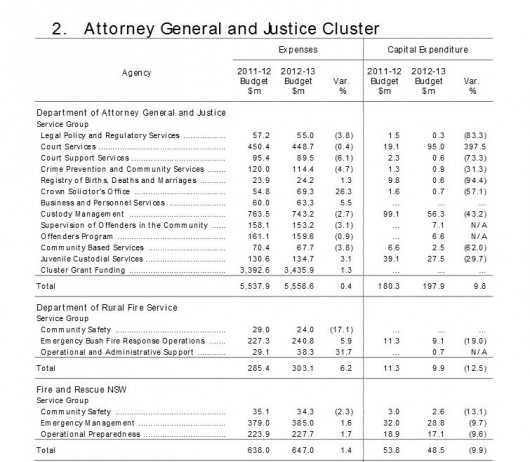 [Source: ‘Budget Paper 3, 2012-13, New South Wales Government, ^http://www.budget.nsw.gov.au/__data/assets/pdf_file/0006/18249/bp3_02attorney_and_justice.pdf] [Source: ‘Budget Paper 3, 2012-13, New South Wales Government, ^http://www.budget.nsw.gov.au/__data/assets/pdf_file/0006/18249/bp3_02attorney_and_justice.pdf]
.
Tuesday, March 5th, 2013
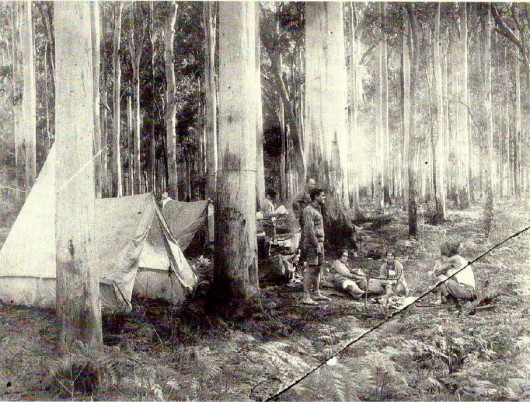 Blue Gum Forest in 1931
An innocent time in fading history – when Platypus were plentiful, bred and swum freely in the Grose River Blue Gum Forest in 1931
An innocent time in fading history – when Platypus were plentiful, bred and swum freely in the Grose River
Party of Sydney Bush Walkers in Blue Gum Forest, circa October 1931
[Source: Photo by Alan Rigby, Blue Gum Forest Committee,
from ‘Back from the Brink: Blue Gum Forest and the Grose Wilderness’ (1997), book by Andy Macqueen, p.256, click image to enlarge]
.
In 2006, the New South Wales (Government’s) Parks and Wildlife Service (NPWS) or ‘Parks‘, being delegated by the Australian Government for absolute responsibility for ecologically protecting the Blue Mountains World Heritage Area (BMWHA), so under-resourced its firefighting effort as to deliberately let the Grose Valley burn out of control.
Senior management well knew, like their firefighting partners the Rural Fires Service, that legal and political accountabilty extended ONLY to protecting private properties and human lives. So this they did and so let 14,070 hectares of the Grose Valley and adjoining land burn. It saved them the cost and effort of future ‘hazard’ reduction.
Parks adopted a cost-saving abandonment strategy (making management look efficient) which it labels deliberate bushfire as ‘fire ecology‘ and so by deliberate under-resourcing of fire fighting against two documented ignitions to then let burn into the Grose Valley and the Blue Gum Forest. These two ignitions (1) a purported lightning strike on Burra Korain Ridge and (2) a deliberate RFS ‘hazard’ reduction burn along the south side of Hartley Vale Road – both outside the BMWHA, were the instigators of the 2006 Grose Fire.
It was all hushed up, despite public calls for an independent public enquiry. Both the RFS Commissioner and Blue Mountains Local Member at the time said no to the public calls for an independent public enquiry. Why?
.
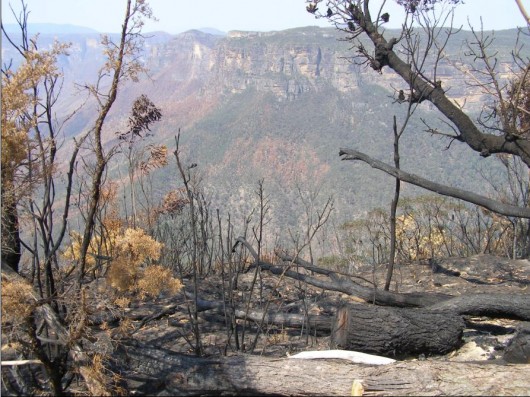 Grose Valley Fire aftermath at Govetts Leap, Blackheath Grose Valley Fire aftermath at Govetts Leap, Blackheath
[Photo by Editor 20061209, click image to enlarge, free in public domain]
.
New South Wales colonists, once they stumbled across the spectacular Grose Valley deep in the Blue Mountains, were in awe in sublime wonder. So it was that initially that the Grose Valley as far back as in 1875 became reserved as a ‘national spectacle’.
But many wanted to dam it – ^Robber Barons and prevailing industrialist politicians of the times had the same view of ‘progress‘ being a colonial right and unquestioningly superior to Nature. They tried to put the railway through the Grose, to mine it, to log it or else to farm it; all so long as the vast ‘resource’ was not neglected for ‘progress‘.
.
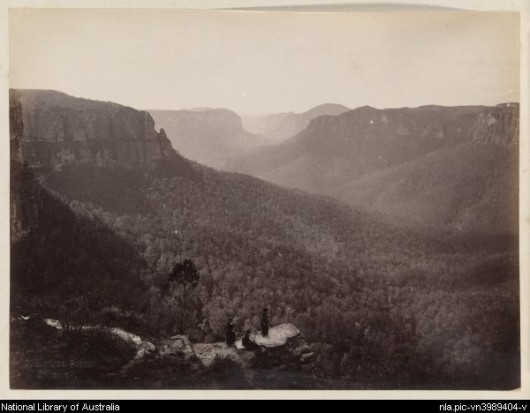 Grose Valley, view from Govett’s Leap in 1886 by Charles Bayliss
Note the women in the foreground in the Victorian dress of the day
[Source: Part of Lindt, J. W. (John William), 1845-1926,
National Library of Australia, 1 digital photograph : b&w,
^http://nla.gov.au/nla.pic-vn3989404] Grose Valley, view from Govett’s Leap in 1886 by Charles Bayliss
Note the women in the foreground in the Victorian dress of the day
[Source: Part of Lindt, J. W. (John William), 1845-1926,
National Library of Australia, 1 digital photograph : b&w,
^http://nla.gov.au/nla.pic-vn3989404]
.
Thankfully, this majestic Grose Valley and its ancient icon Blue Gum Forest were saved the axe in 1931. But is was only marginally due to the persistent campaigning efforts of a small dedicated group of bushwalkers passionate about saving this forest back even in the midst of The Great Depression.
If ever a case were not truer:
“Never doubt that a small group of thoughtful, committed people can change the world. Indeed, it is the only thing that ever has.”
~ American cultural anthropologist, Margaret Mead
. Margaret Mead, 1901–1978 Margaret Mead, 1901–1978
.
‘The Blue Gum‘ was ultimately saved by the generous personal donation by allied bushwalker W.J. Cleary of £80 [perhaps $20,000 in today’s value *] to purchase the rights to the land from the pastoralist Clarrie Hungerford in February 1932.
.
Significantly, their dedicated act of environmental conservation is arguably the first environmental campaign in Australia’ history. ‘The Blue Gum‘ since then and for eighty years since has been affectionately known amongst environmentalists as ‘The Cradle of Conservation‘.
[Ed: * CALCULATION: In 1930, the average yearly wage for ordinary Australian workers was roughly £220, source: ^http://guides.slv.vic.gov.au/content.php?pid=14258&sid=95522. So given that today’s average yearly salary in Australia is about $56,000 (Source: ^http://www.abs.gov.au), the calculation is 80/220 * 56,000 = $20,000]
.
<<Everyone has been to the lookouts. Many have been to the Blue Gum Forest, deep in the valley– but few know the remote & hidden recesses of the labyrinth beyond. Here, an hour or two from Sydney, is a very wild place.
The Grose has escaped development. There have been schemes for roads, railways, dams, mines & forestry, but the bulldozers have been kept out. Instead, the valley became the Cradle of Conservation in New South Wales when it was reserved from sale in 1875 – an event magnificently reinforced in 1931 when a group of bushwalkers were moved to save the Blue Gum Forest from the axe.
Local author, Andy Macqueen, has been an enthusiastic bushwalker and conservationist since the 1960’s. In 1997, he published his book, ‘Back from the Brink: Blue Gum Forest and the Grose Wilderness‘, aptly titled in telling the true story of how the Blue Gum Forest was saved from destruction.
Macqueen’s well researched book tells in detail the story of the whole Grose Wilderness experience and of the Blue Gum Forest rescue story in particular. It tells about the many different people who have visited this wilderness: Aborigines, explorers, engineers, miners, track builders, bushwalkers, canyoners, climbers…those who have loved it, and those who have threatened it.>>
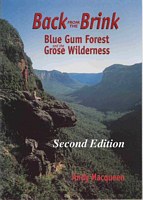 Available from Megalong Books, Leura in the Blue Mountains
^http://shop.megalongbooks.com.au/bookweb/details.cgi?ITEMNO=9780646476957
^http://www.megalongbooks.com.au/ Available from Megalong Books, Leura in the Blue Mountains
^http://shop.megalongbooks.com.au/bookweb/details.cgi?ITEMNO=9780646476957
^http://www.megalongbooks.com.au/
.
Other books about the Blue Mountains:
^http://www.lamdhabooks.com.au/bluemountainscatalogue.htm
.
Hazard Reduction Revenge
.
A decade later, in 1940 the Grose Valley was subjected to a bushfire; however its cause, circumstances and extent of damage are unknown by The Habitat Advocate.
This bushfire occurred only a year after the devastating 1939 Bushfires of ‘Black Friday‘ across Victoria, which is collectively considered one of the worst natural bushfires (wildfires) in the world. Almost 20,000 km² (2 million hectares) was burnt, 71 people perished and several significant native forests were destroyed (Victorian Alps, Yarra Ranges, Otway Ranges, Grampians and Strzelecki Ranges) and the townships of Dromana, Healesville, Kinglake, Marysville, Narbethong, Warburton, Warrandyte, Yarra Glen, Hill End, Nayook West, Matlock, Noojee, Omeo, Woods Point, Pomonal and Portland.
The subsequent Royal Commission, under Judge L.E.B Stretton (known as the Stretton Inquiry), attributed blame for the fires to careless burning, such as for campfires and land clearing.
It was the second major bushfire tragedy since the 1851 Black Thursday Bushfires which wiped out 5 million hectares of Victoria.
.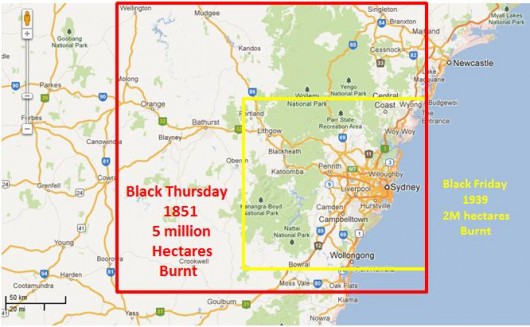 Bushfire Tragedy in aggregated geographical context.
So why are Australian wildlife hard to find in their natural bush habitat? Bushfire Tragedy in aggregated geographical context.
So why are Australian wildlife hard to find in their natural bush habitat?
.
More recently a disturbing ‘bushphobic culture‘ has produced a need to burn it for its burning sake. One must wonder whether our society has indeed advanced, matured or just ‘progressed‘ its colonialism?
.
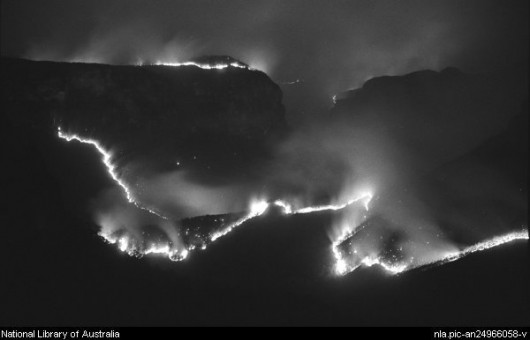 Grose Valley Bushfire of 25th October 2002
[Source: Image by Paul Cosgrave, National Library of Australia, 2003,
1 digital photograph : b&w.http://nla.gov.au/nla.pic-an24966058] Grose Valley Bushfire of 25th October 2002
[Source: Image by Paul Cosgrave, National Library of Australia, 2003,
1 digital photograph : b&w.http://nla.gov.au/nla.pic-an24966058]
.
In 2006, the Grose Valley was incinerated in a massive firestorm and this time the fire ripped through the Blue Gum Forest..
.
.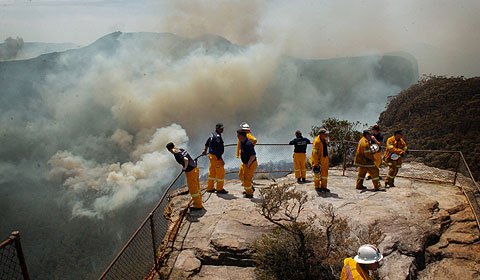 Firefighters watching the escalating bushfire incinerating the Grose Valley below
22 November 2006 – the day before the Grose Firestorm
Picture: Brad Newman, in The Australian. Firefighters watching the escalating bushfire incinerating the Grose Valley below
22 November 2006 – the day before the Grose Firestorm
Picture: Brad Newman, in The Australian.
.
<<Residents in towns across NSW waited for the worst last night as bushfires burned thousands of hectares across the state and dry conditions were forecast for almost the entire continent for another week.
Spot fires from a 10-day-old bushfire burning in the Blue Mountains came within a few hundred metres of houses in Blackheath. Katoomba, Mount Tomah and Lawson and other towns in the region were also under threat from the worst bushfire in the nation.
“There was virtually no cloud over the entire continent,” said Julie Evans from the NSW Bureau of Meteorology of the dry conditions expected to continue across most of Australia in the coming week.
As mild weather and a cool change provided relief to firefighters in South Australia and Victoria, smoke from the Blue Mountains blaze, which was last night largely contained in the Grose Valley, rose more than 12km into the air, causing ash to fall on central Sydney and effectively creating its own weather system.
Watching from a helicopter above the flames, National Parks and Wildlife Service acting regional manager Kim De Govrik said the explosion as the fire crowned in the tree-tops around the Banks Wall cliff-face was “like a nuclear bomb going off”.
Sparks ignited fires up to 15km away, near Faulconbridge, home of Rural Fire Service Commissioner Phil Koperberg, who is directing the operation to contain the state’s fires.
“By tomorrow morning, it wouldn’t be unreasonable to expect that there will be additional fires around the countryside,” Mr Koperberg said yesterday.
About 2000 firefighters spent the day battling about 44 fires across NSW, five of which the RFS said it was unable to contain. Molong enjoyed a reprieve after a late wind shift caused a fire to change direction just 4km from the central-western town. Residents were relocated to a community centre last night, while an unoccupied house and vehicle were destroyed by the fire.
The RFS met residents in the Hawkesbury and Goulburn regions early last night to update them on the fires and what they can do to prepare their homes.
The bushfires also led to blackouts across Sydney. Just a week after the city endured its coldest November night in a century, the city sweltered through its third-hottest November day in 25 years — the official maximum temperature was 38.4C. Dozens of suburbs in the city’s west and southwest were affected by the outages, as were large sections of the CBD.
The NSW parliament was twice plunged into darkness as the power surges hit in the late afternoon, with the second one lasting several minutes.
Mild weather led the bushfire threat across South Australia to fall. CFS spokeswoman Krista St John said the state’s southeast had been hardest hit, with fires burning about 8500ha.
In Victoria, a cool change helped firefighters bring the state’s larger fires under control, although lightning strikes ignited several smaller fires in the west of the state.>>
.
[Source: ‘Fires and dry conditions have residents fearing the worst’, 20061123, by Dan Box and Simon Kearney; additional reporting by Padraig Murphy and AAP, The Australian newspaper, ^http://www.theaustralian.com.au/news/fires-and-dry-conditions-have-residents-fearing-the-worst/story-e6frg6o6-1111112569927]
.
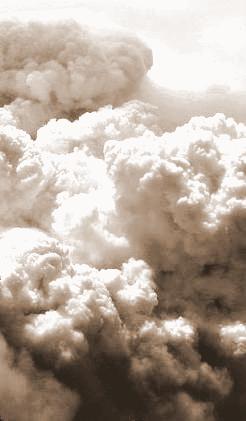 23 November 2006
14,070 hectares of precious Blue Mountains habitat incinerated
So why are Australian wildlife hard to find in their natural bush habitat? 23 November 2006
14,070 hectares of precious Blue Mountains habitat incinerated
So why are Australian wildlife hard to find in their natural bush habitat?
.
 The home that Parks had it in for … the Blue Gum Forest’s fire-scarred trees,
some of which have graced the Grose Valley for hundreds of years.
The home that Parks had it in for … the Blue Gum Forest’s fire-scarred trees,
some of which have graced the Grose Valley for hundreds of years.
A defacto hazard reduction burn.
[Photo: Nick Moir, ^http://www.nickmoirphoto.com/]
.
<<More than 70 years ago this forest inspired the birth of the modern Australian conservation movement. Today Blue Gum Forest stands forlorn in a bed of ash.
But was it unnecessarily sacrificed because of aggressive control burning by firefighters focused on protecting people and property? That is the tough question being asked by scientists, fire experts and heritage managers as a result of the blaze in the Grose Valley of the upper Blue Mountains last month.
As the fate of the forest hangs in the balance, the State Government is facing demands for an independent review of the blaze amid claims it was made worse by control burning and inappropriate resources.
This comes against a backdrop of renewed warnings that Australia may be on the brink of a wave of species loss caused by climate change and more frequent and hotter fires. There are also claims that alternative “ecological” approaches to remote-area firefighting are underfunded and not taken seriously.
In an investigation of the Blue Mountains fires the Herald has spoken to experienced fire managers, fire experts and six senior sources in four agencies and uncovered numerous concerns and complaints.
* It was claimed that critical opportunities were lost in the first days to contain or extinguish the two original, separate fires.
* Evidence emerged that escaped backburns and spot fires meant the fires linked up and were made more dangerous to property and heritage assets – including the Blue Gum Forest. One manager said the townships of Hazelbrook, Woodford and Linden were a “bee’s dick” away from being burnt. Another described it as “our scariest moment”. Recognising the risk of the backburn strategy, one fire officer – before the lighting of a large backburn along the Bells Line of Road – publicly described that operation as “a big call”.
It later escaped twice, advancing the fire down the Grose Valley.
.
- Concerns were voiced about the role of the NSW Rural Fire Service Commissioner, Phil Koperberg.
- Members of the upper Blue Mountains Rural Fire Service brigades were unhappy about the backburning strategy.
- There were doubts about the mix and sustainability of resources – several senior managers felt there were “too many trucks” and not enough skilled remote-area firefighters.
- Scientists, heritage managers and the public were angry that the region’s national and international heritage values were being compromised or ignored.
- There was anecdotal evidence that rare and even common species were being affected by the increased frequency and intensity of fires in the region.
- Annoyance was voiced over the environmental damage for hastily, poorly constructed fire trails and containment lines, and there were concerns about the bill for reconstruction of infrastructure, including walking tracks.
.
The fire manager and ecologist Nic Gellie, who was the fire management officer in the Blue Mountains for the NSW National Parks and Wildlife Service during the 1980s and ’90s, says the two original fires could have been put out with more rapid direct attack.
“Instead, backburning linked up the two fires and hugely enlarged the fire area … what we saw would be more accurately described as headfire burning, creating hot new fire fronts. While it protected the town of Blackheath, the plateau tops burnt intensely – and that created new problems both for management of the fire and the protection of biodiversity.
“When extreme fire weather, hot days and high winds arrived as predicted, the expanded fire zone was still not fully contained – and that was the cause of most of the high drama and danger that followed.”
In that dramatic week, Mr Gellie confronted Mr Koperberg with his concerns that the commissioner was interfering with the management of the fire by pushing hard for large backburns along the northern side of towns in the Blue Mountains from Mount Victoria to Faulconbridge, along what is known in firefighting circles as the “black line”.
The Herald has since confirmed from numerous senior sources that “overt and covert pressure” from head office was applied to the local incident management team responsible for fighting the fire.
There were also tensions relating to Mr Koperberg’s enthusiasm for continuation of the backburning strategy along the black line – even when milder weather, lower fuel levels and close-in containment were holding the fire.
Several sources say the most frightening threat to life and property came as the fire leapt onto the Lawson Ridge on “blow-up Wednesday” (November 22) – and that those spot fires almost certainly came from the collapse of the convection column associated with the intensification of the fire by the extensive backburns.
.
The Herald has also confirmed that:
- The original fire lit by a lightning strike near Burra Korain Head inside the national park on Monday, November 13, could not be found on the first day. The following day, a remote area fire team had partly contained the fire – but was removed to fight the second fire. The original fire was left to burn unattended for the next couple of days;
.
- An escaped backburn was responsible for the most direct threat to houses during the two-week emergency, at Connaught Road in Blackheath. However, at a public meeting in Blackheath on Saturday night, the Rural Fire Service assistant commissioner Shane Fitzsimmons played down residents’ concerns about their lucky escape. “I don’t want to know about it. It’s incidental in the scheme of things.”
.
Mr Koperberg, who is retiring to stand as a Labor candidate in next year’s state elections, rejected the criticisms of how the fire was fought. He told the Herald: “The whole of the Grose Valley would have been burnt if we had not intervened in the way we did and property would have been threatened or lost. We are looking at a successful rather than an unsuccessful outcome.
“It’s controversial, but this is world’s best backburning practice – often it’s the only tool available to save some of the country.”
The commissioner rejected any criticism that he had exerted too much influence. “As commissioner, the buck stops with me. I don’t influence outcomes unless there is a strategy that is so ill-considered that I have to intervene.”
Mr Koperberg said it was “indisputable and irrefutable” that the Blue Mountains fire – similar to fires burning now in Victoria – was “unlike any that has been seen since European settlement”, because drought and the weather produced erratic and unpredictable fire behaviour.
The district manager of the Blue Mountains for the Rural Fire Service, Superintendent Mal Cronstedt, was the incident controller for the fire.>>
.
[Source: ‘The ghosts of an enchanted forest demand answers’, 20061211, by Gregg Borschmann, Sydney Morning Herald, p.1, ^http://www.smh.com.au/news/national/the-ghosts-of-an-enchanted-forest-demand-answers/2006/12/10/1165685553891.html?page=fullpage#contentSwap2]
.
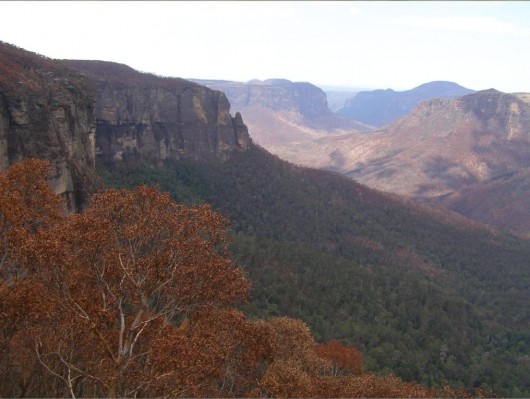 Grose Valley’s bushphobic habitat incinerated
because in the minds of Parks and the Rural Fire Service it was a fuel hazard
Click image to enlarge,
Photo by Editor 20070106, free in public domain Grose Valley’s bushphobic habitat incinerated
because in the minds of Parks and the Rural Fire Service it was a fuel hazard
Click image to enlarge,
Photo by Editor 20070106, free in public domain
.
<<A bushfire scars a precious forest – and sparks debate on how we fight fire in the era of climate change, writes Gregg Borschmann.
The ghosts of an enchanted forest demand answers
“Snow and sleet are falling on two bushfires burning in the Blue Mountains west of Sydney.”
ABC Radio, November 15: The news report was almost flippant, something that could happen only in Dorothea Mackellar’s land of drought and flooding rains. Later that evening, two weeks from summer, Sydney had its coldest night in more than a century.
Over the past month – as an early summer collided with a late winter and a decade-long drought – NSW and Victoria have battled more than 100 bushfires.
But of them all, last month’s Blue Mountains blaze reveals tensions and systemic problems that point to a looming crisis as bushfire fighters struggle to protect people, property, biodiversity and heritage values in a world beset by climate change.
The tensions have always been there – different cultures, different ways of imagining and managing the landscape. Perhaps they are illustrated by a joke told by two Rural Fire Service crew in the Blue Mountains. “How does the RFS put out a fire in your kitchen? By backburning your sitting room and library.” The joke barely disguises the clash between the imperative of saving lives and homes, and the desire to look after the land, and the biodiversity that underpins our social and economic lives.
For fire managers, whose first priority will always be saving people and property, the equation has become even more tortured with a series of class actions over fires in NSW and the ACT. As one observer put it: “These guys are in a position where they’re not going to take any chances. No one will ever sue over environmental damage.”
For bushfire management the debate tentatively started a couple of decades ago. The challenge was to do what poets, writers and painters have long grappled with – coming to terms with a country whose distinctiveness and recent evolutionary history have been forged in fire.
Drought and climate change now promise to catapult that debate to centre stage.
It is perhaps no accident that such a defining fire has occurred in one of the great amphitheatres of the Australian story, the Grose Valley in the upper Blue Mountains. Charles Darwin passed by on horseback in 1836, and described the valley as “stupendous … magnificent”.
The Grose has long been a microcosm of how Australians see their country. In 1859 some of the first photos in Australia were taken in the valley. Proposals for rail lines and dams were forgotten or shelved. The first great forest conservation battle was fought and won there in 1931-32.
But now the valley is under threat from an old friend and foe – fire.
Ian Brown has worked on dozens of fires in the Blue Mountains. He is a former operations manager for the National Parks and Wildlife Service.
“All fires are complex and difficult, and this sure was a nasty fire … But we need lots of tools in the shed. Those hairy, big backburns on exposed ridges so close to a blow-up day with bad weather surprised me. Frightened me even.”
For Brown, even more worrying is the trend.
“Parts of the Grose have now burnt three times in 13 years and four times in 24 years. Most of those fires started from arson or accident. Many of the species and plant communities can’t survive that sort of hammering.”
Ross Bradstock, a fire ecologist, agrees. Professor Bradstock is the director of the new Centre for the Environmental Risk Management of Bushfires at the University of Wollongong, which is funded by the Department of Environment and Conservation and the Rural Fire Service. He says Australia stands out as one of the countries whose vegetation may be most affected by climate change.
Bradstock says that in south-eastern Australia the potential for shifts in fire frequency and intensity are “very high … If we’re going to have more drought we will have more big fires.”
But the story is complicated and compounded by the interaction between drought and fire. The plants most resistant to fire, most able to bounce back after burning, will be most affected by climate change. And the plants that are going to be advantaged by aridity will be knocked over by increased fire frequency. “In general, the flora is going to get whacked from both ends – it’s going to be hit by increased fire and climate change. It’s not looking good.”
Wyn Jones, an ecologist who worked for the wildlife service, says the extremely rare drumstick plant, Isopogon fletcheri, is a good example. There are thought to be no more than 200 specimens, restricted to the upper Grose. Last week, on a walk down into the Blue Gum Forest, Jones found three – all killed by the fire.
The NSW Rural Fire Service Commissioner, Phil Koperberg, has been a keen supporter of Bradstock’s centre. Asked if he agreed with the argument that the Grose had seen too much fire, Mr Koperberg replied: “It’s not a comment I disagree with, but had we not intervened in the way we did, the entire Grose Valley would have been burnt again, not half of it.”
The great irony of the fire is that it was better weather, low fuels and close-in containment firefighting that eventually stopped the fire – not big backburns.
Remote area firefighting techniques have been pioneered and perfected over recent decades by the wildlife service. In 2003 a federal select committee on bushfires supported the approach. It recommended fire authorities and public land managers implement principles of fire prevention and “rapid and effective initial attack”.
Nic Gellie, a fire ecologist and former fire manager, has helped the wildlife service pioneer ecological fire management. The models are there – but he says they have not been used often enough or properly.
Doubts have been expressed about the sustainability of the current remote area firefighting model. It is underfunded, and relies on a mix of paid parks service staff and fire service volunteers. Most agree the model is a good one, but not viable during a longer bushfire relying on volunteers.
The Sydney Catchment Authority pays $1 million for Catchment Remote Area Firefighting Teams in the Warragamba water supply area. It has always seemed like a lot of money. But it looks like a bargain stacked against the estimated cost of $10 million for the direct costs and rehabilitation of the Grose fire.
Curiously, one unexpected outcome of the great Grose fire may be that the valley sees more regular, planned fire – something the former wildlife service manager Ian Brown is considering.
“If climate change means that the Grose is going to get blasted every 12 years or less, then we need more than just the backburning strategy. We need to get better at initial attack and maybe also look at more planned burns before these crises. But actually getting those burns done – and done right – that’s the real challenge.”
It may be the only hope for Isopogon fletcheri.
Asked if he would do anything differently, Mr Cronstedt answered: “Probably.” But other strategies might have also had unknown or unpredictable consequences, he said.
Jack Tolhurst, the deputy fire control officer (operations) for the Blue Mountains, said: “I am adamant that this fire was managed very well. We didn’t lose any lives or property and only half the Grose Valley was burnt.”
Mr Tolhurst, who has 50 years’ experience in the Blue Mountains, said: “This fire is the most contrary fire we have ever dealt with up here.”
John Merson, the executive director of the Blue Mountains World Heritage Institute, said fire management was being complicated by conditions possibly associated with climate change.
“With increased fire frequency and intensity, we are looking at a fundamental change in Australian ecosystems,” he said. “We will lose species. But we don’t know what will prosper and what will replace those disappearing species. It’s not a happy state. It’s a very tough call for firefighters trying to do what they think is the right thing when the game is no longer the same.
“What we are seeing is a reflex response that may no longer be appropriate and doesn’t take account of all the values we are trying to protect.”>>
.
[Source: ‘ The burning question’, 20061211, by Gregg Borschmann (producer for ABC Radio National), Sydney Morning Herald, p.10, ^http://www.smh.com.au/news/national/the-burning-question/2006/12/10/1165685553945.html?page=fullpage#contentSwap1]
.
So why are Australian wildlife hard to find in their natural bush habitat?
.
Monday, February 25th, 2013
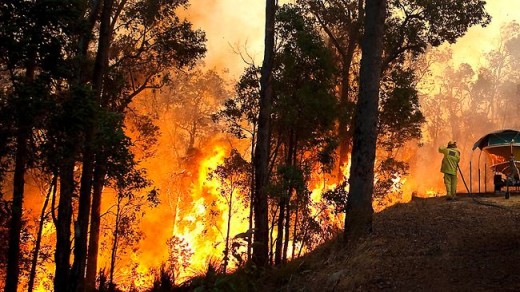 Perth Hills Bushfires at Roleystone, Feb 2011
(Photo credit: AP) Perth Hills Bushfires at Roleystone, Feb 2011
(Photo credit: AP)
.
In our technologically advanced society, many people now wrongly presume that Humanity has elevated itself above Nature and so no longer needs to respect it. This misguided attitude extends to government.
In Australia, people continue to build homes in flood prone river plains, and governments continue to approve them. People continue to build homes in bushfire prone areas that are indefensible from bushfire, yet governments continue to approve their construction.
Almost every year now, a natural disaster hits a community somewhere in Australia.
.
The Once in a Hundred Year Event is a Vernacular Myth
.
So is it community ignorance, memory loss, denial or primeval fatalism? Perhaps it is just plain old foolhardiness – she’ll be right, it won’t happen to me, our technologically advanced society has insulated us from the forces of Nature.
Lives, property and what’s left of native Australia (its flora and fauna) suffer or are devastatingly lost to natural disasters, and also disturbingly to Man-made ones. Unprepared communities suffer, go into shock, and experience trauma. They question and with the self-serving interests of commercial media seek answers, get angry, seek blame, and call on government to explain and learn from its failure to protect them from Nature’s fury. In the case of bushfire disasters, as Australia’s encouraged expanding human population encroaches further into the Australian bush, people have become inherently more susceptible to bushfire risk. So when bushfire tragedy occurs, these people blame government and call for the inevitable ‘enquiry’. Governments react by delivering enquiries.
Since the 1939 Black Friday bushfire catastrophe, Australia has a library full of these post-disaster government enquiries. But are we learning from all these enquiries? Are we better prepared and able to cope with Nature’s fury?
Governments may be getting better at emergency management but the pace appears incremental. At each disaster, government’s emergency management comes under criticism in the ensuing enquiry, which sends a message that government emergency management is always falling well short of community expectations. Then after each enquiry and its report into what, why, how and why not in readiness and response to the natural disasters, what lessons are put into action? History shows repeatedly that short-term memory prevails, government finds a scapegoat, increases the emergency management budget, then getrs distracted on other political priorities of the day; but otherwise reverts to business-as-usual laissez faire. The same policy, systems, people and infrastructrure are left in place, which is most convenient to government, but which most sets the scene for future failure all over again.
Government across Australia, at all its duplicated levels, has a fundamental civic duty to do their utmost to protect citizens from disasters – invasion, storms, floods, bushfires. Given the increasing trend in the scale, severity and frequency of natural disasters and the increased exposure of more people in harms way, governments’ business-as-usual convenience is not good enough..
‘A Geneva based research centre has described 2010 as the deadliest year from natural disasters in two decades – and Australia ranks in the top ten countries affected. The 12th January 2010 earthquake in Haiti devastated the island nation and killed over 222,000 people. Some 373 natural disasters killed over 296,800 people in 2010, affecting nearly 208 million others and costing nearly US$110 billion, according to the Centre for Research on the Epidemiology of Disasters (CRED).’
[Source: ^http://www.probonoaustralia.com.au/news/2011/01/deadliest-year-natural-disasters-2010]
.
Now that these risks are well know and more probable, it is not only not good enough, it is clear that governments have become grossly negligent in its civic duty to properly invest in emergency management. Yet risk is not matched with resourcing. Or is it that Australians are content with taking a fatalistic approach to Nature’s fury? Are Australians content for our governments to continue with their ‘business-as-usual’ political priorities and conveniences, ignoring emergency management?
But Australian values have evolved. Australian society expects emergency management to more than to protect ‘life and property’. Many in our society now place a high value also on livestock, arable land, native forests and native animals. As Australia’s population has increased considerably, these once taken for granted assets of Australia have become scarcer and so more valuable. Whilst human life and property remains of course the highest priority, to ignore these and to lose these in bushfire has become increasingly unacceptable to many Australians. But if these evolved values have not been adopted by government emergency management then there has become a serious disconnect between government priorities and the communities it represents. Public debate on this disconnect is long overdue.
In Australia and in our region it’s now become ‘another season, another natural disaster’. Tragically, in just the past four years, Australians have witnessed Nature’s fury and government failure in emergency management to protect and mitigate the loss of what we value:
.
- 2009 SE Australia 3-week heatwave
- 2009 Victoria’s Black Saturday bushfires
- 2009 Perth bushfires at Badgingarra and Toodyay
- 2009 Boorabin NP bushfire (WA)
- 2009 Samoa earthquake and tsunami
- 2009 Severe hails storms across NSW & ACT
- 2010 Severe storm hits Perth
- 2010 Severe storm hits Melbourne
- 2010 Cyclone Yasi in Far North Queensland
- 2010 Queensland Floods
- 2011 Christchurch Earthquakes
- 2011 Perth Hills bushfires
- 2011 Japanese earthquake and tsunami
- 2011 Ash cloud grounds many Australian flights
- 2011 Floods in northern NSW and Wollongong
- 2011 Severe storm hits Perth
- 2011 Floods in central Victoria
- 2011 Queensland Floods -Lockyer Valley, Brisbane River, Rockhampton, etc
- 2012 Queensland Floods
- 2012 Cyclone Lua in WA Pilbara
- 2012 Cyclone Iggy along WA coast
- 2012 Cyclone Heidi in WA Pilbara
- 2012 Port Lincoln Bushfire in South Australia
- 2012 Bushfire in the Gascoyne, WA
- 2012 Storms across SE Queensland
- 2013 Tasmanian Bushfires
- 2013 NSW Bushfires
- 2013 Victorian Bushfires
- 2013 Western Australia Bushfires
- 2013 Eastern Australia Floods
.
This list is not exhaustive and we are not yet through 2013.
.
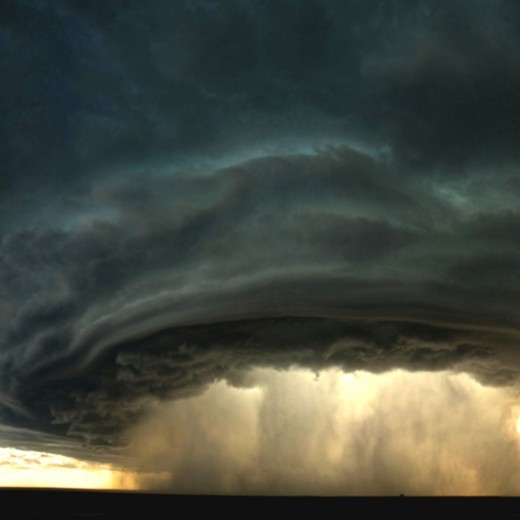 . .
|
|
 Windsor Downs Nature Reserve ablaze
Windsor Downs Nature Reserve ablaze Map showing the juxtaposition of the Windsor Downs Nature Reserve over 3 km north west from Garfield Road in Riverstone.
Journalists have a lot to answer for when it comes to fact checking during emergencies.
[Source: Google Maps 2013, click image to enlarge]
Map showing the juxtaposition of the Windsor Downs Nature Reserve over 3 km north west from Garfield Road in Riverstone.
Journalists have a lot to answer for when it comes to fact checking during emergencies.
[Source: Google Maps 2013, click image to enlarge]
 Windsor Downs native woodland habitat being burned alive
[Source: ‘Bushfires threaten Sydney’s western suburbs – NSW Rural Fire Service issues emergency warnings’, 20130910, Sydney Morning Herald newspaper (Sydney), ^http://www.smh.com.au/environment/bushfires-threaten-sydneys-western-suburbs-nsw-rural-fire-service-issues-emergency-warnings-20130910-2thnl.html]
Windsor Downs native woodland habitat being burned alive
[Source: ‘Bushfires threaten Sydney’s western suburbs – NSW Rural Fire Service issues emergency warnings’, 20130910, Sydney Morning Herald newspaper (Sydney), ^http://www.smh.com.au/environment/bushfires-threaten-sydneys-western-suburbs-nsw-rural-fire-service-issues-emergency-warnings-20130910-2thnl.html]
 A liar bird of disinterested political masters
A liar bird of disinterested political masters [Source: Australian Bureau of Meteorology,
^http://www.bom.gov.au/climate/dwo/201309/html/IDCJDW2119.201309.shtml]
[Source: Australian Bureau of Meteorology,
^http://www.bom.gov.au/climate/dwo/201309/html/IDCJDW2119.201309.shtml]
 Windsor Downs Nature Reserve ablaze (from Hawkesbury Lookout)
Windsor Downs Nature Reserve ablaze (from Hawkesbury Lookout) Windsor Downs Nature Reserve incinerated (see browned woodland canopy in centre of photograph)
[Photo taken by Editor from Hawkesbury Lookout looking north east on 20130921, photo © under ^Creative Commons]
Click image to enlarge
Windsor Downs Nature Reserve incinerated (see browned woodland canopy in centre of photograph)
[Photo taken by Editor from Hawkesbury Lookout looking north east on 20130921, photo © under ^Creative Commons]
Click image to enlarge
 Critically Endangered Regent Honeyeater
(Anthochaera phrygia)
A native bird species dependant upon a disappearing habitat
Humans obliterated its habitat for logging, farming and housing
Then we constrained it to a few nature reserves like Windsor Downs,
Then we burnt the reserve.
Critically Endangered Regent Honeyeater
(Anthochaera phrygia)
A native bird species dependant upon a disappearing habitat
Humans obliterated its habitat for logging, farming and housing
Then we constrained it to a few nature reserves like Windsor Downs,
Then we burnt the reserve.



































































